
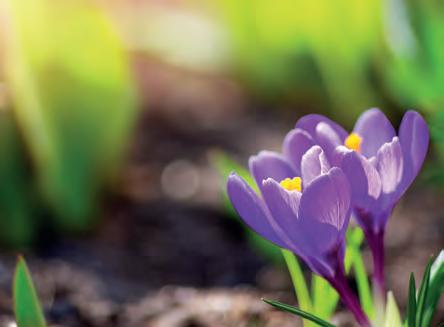
www.countrygardener.co.uk SPEARS OF DELIGHT May is the month to lavish on sensational asparagus PLUS: Gardening through arthritis Heavenly cactus Lichens and ladybirds Flower clock gardens Clematis woes What will May weather bring Gardens open in Somerset in May Bees in your garden Somerset Issue No 210 MAY 2024 FREE Planting Outdoor Living Cafe Fonthill Garden Centre Bath Road, Bitton, Bristol BS30 6HX Call: 0117 932 3110 Lakeside Garden Centre Crockerton, Warminster, Wiltshire BA12 8AP Call: 01985 217 413 www.fonthill-lakeside.com

MART ROAD, MINEHEAD, SOMERSET TA24 5BJ
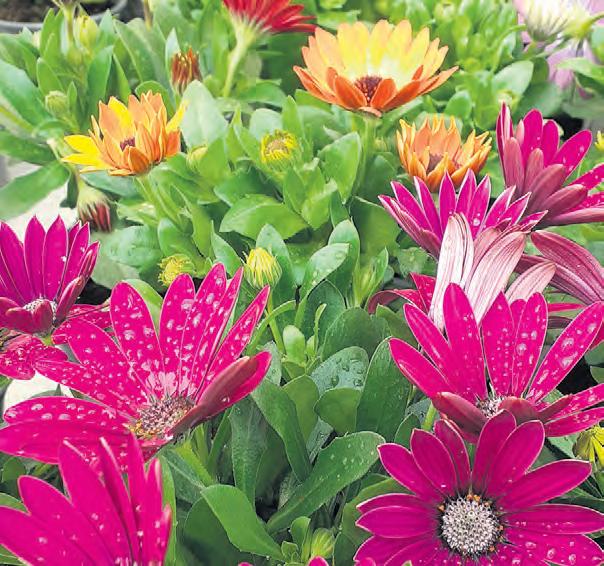
SUPERB SELECTION OF SUMMER BEDDING
• Also Hanging Baskets, Pots, & Troughs
WIDE RANGE OF VEGETABLE, SALAD & HERB PLANTS
• Also Strawberries, Soft Fruit & Fruit Trees
NEW SEASON PERENNIALS & SHRUBS
• Top Quality Timber Garden Furniture, Dining Sets & Colourful Parasols
• Special Offers on selection of Rattan Furniture
Relax in our cafe over Breakfast, Lunch or Afternoon Tea with Homemade Cake. Booking essential for our weekly Wednesday Roast.
Find inspiration throughout the year on our Website, Facebook and Instagram
PROFESSIONAL
LANDSCAPING SERVICE
OPEN 7 DAYS A WEEK MON-SAT 9AM-5PM
SUN 10AM-4PM
T: 01643 703612 E: enquiries@wsgardencentre.co.uk
www.westsomersetgardencentre.co.uk


2
Country Gardener
Gardeners cuttings in Somerset
A LOOK AT NEWS, EVENTS AND HAPPENINGS IN YOUR AREA
Welcome wildlife this Hedgehog Awareness Week
Hedgehogs are already enjoying a high profile but there’s more emphasis on the problems hedgehogs face and how you can help them during Hedgehog Awareness Week happening from 5th to 11th May.
This year the charity is asking people to ‘Welcome Wildlife!’ by creating space for wildlife in their own gardens or green spaces and encouraging landowners such as schools and councils to do the same.
There are also lots of lovely wildlife-friendly features that can be added (and hazards that can be avoided) to make an area more welcoming to hedgehogs: Hedgehog highways allow vital access to more habitat; These 13cm x 13cm square gaps in the bottom of boundary walls and fences ensure hedgehogs can get in and out easily.
“All gardeners know better than other gardeners - especially in May” - Anon
“True gardeners cannot bear a glove between the sure touch and the tender root” - Mary Sarton
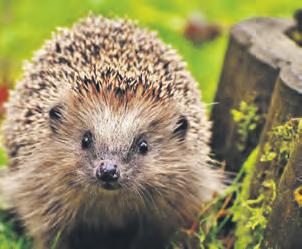
Log piles, leaf piles, wild corners and edges will attract natural food and offer shelter for hedgehogs.
Ponds or pools are great for wildlife but do ensure there are escape routes – a sloping edge, ramp or half-submerged rock for hedgehogs to scramble out on.
Stop using poisons and pesticides that could directly harm wildlife and destroy the food chain.
You can join BHPS as a supporter from £7.50 a year for an individual in the UK (or £12.50 for a family). Join at www.britishhedgehogs.org.uk/join-us/ or by phone on 01584 890 801.
Leaflets and posters are available at www.britishhedgehogs.org.uk
New weekend Spring Fair at Hestercombe
Hestercombe House and Gardens is hosting a new two day Spring Fair at the beginning of May. Held over the weekend of Saturday 4th and Sunday 5th May. It’s a chance to explore 40 local artisan stalls with a range of beautiful gifts, plants, delicious homemade food and drink offering and unique hand-crafted items. There will also be free face painting available (10am to 3pm), as well as musicians and live entertainment throughout the weekend. On sale will be delicious food and drink including homemade cakes, hot dogs and pizza. Visitors to the fair will also receive free admission to the gardens, house and contemporary art gallery. 9am to 7pm. Pricing: £7.65 for adults / £3.83 for children / Free for Members. Hestercombe Gardens, Taunton TA2 8LG
Rare Plant Fair at The American Museum and Gardens
Rare Plant Fair returns to Bath in May at the The American Museum and Gardens, on Sunday 19th May.
This is the only museum of Americana outside of the United States and was founded to bring American history and cultures to the people of Britain and Europe.
The fair will be open from 10am to 5pm, and entry to the fair and garden costs £11 for adults and £7.50 for children aged 5 to 17. The ticket price includes a voluntary donation. (Prices without voluntary donation: Adults £9, child 5-17 £6).
The museum and exhibitions are also open on the day (additional fee payable). Lunches and refreshments will be available from The American Garden Deli.
There is a great selection of specialist nurseries all of whom are experts in the plants that they grow. Visit www.rareplantfair.co.uk for full details of the Fair.
American Museum & Gardens, Claverton Manor, Bath BA2 7BD


YARLINGTON HOUSE HOSTS MAY SPRING FAIR
Yarlington House near Wincanton is hosting a Spring Plant Fair on Saturday, 11th May with over 30 nurseries selling their home-grown top-quality plants.
There will be organic herbs and vegetable plants, roses and climbers, perennials and grasses, traditional wildflowers, and exciting new introductions.
Admission is £5 per person, with ticket sales benefitting the Church of St Luke and St Teresa, in Wincanton.
Tickets include free access to the gardens not normally open to the public.
Refreshments are available and dogs on leads are welcome.
Full details, including stall holders at www.plantfairs.com

New irrigation plans now in place at Tintinhull Gardens
Tintinhull Gardens re-open with new sustainable watering plans
Tintinhull Gardens, the National Trust property near Yeovil, has reopened for the new season and taken some major steps towards making the property’s future more sustainable. They include actions such as taking the garden off mains water supply. With the growing trend for longer, hotter, and significantly drier summers, an automated watering system has been introduced in part of the garden.
It used rainwater from harvesting tanks to irrigate the Kitchen Garden in the summer months. It was a great success, keeping the ground moist and the plants green during times when there was little rain.
Building on that success, another two large water tanks were installed during the winter, meaning the whole site was taken off mains water for irrigation purposes. This step means that the environmental impact of the garden is significantly reduced, but an additional bonus for staff and volunteers is the time taken to water the garden has lessened – from 16 hours per week to zero.
Alex Newman, senior gardener, said: “We have been busy like the proverbial bees, pruning, mulching, and carrying out a lot of maintenance. We’re also very pleased to have taken steps towards being better prepared for the challenges of climate change.
Other changes that people may notice when visiting include the replanting of the purple and gold border in Cedar Court to make it more historically accurate, ensure it has year-round colour, and greater resilience to extreme weather conditions. Lobelia
‘Hadspen Purple’ has been introduced to the border, which is a nod to Penelope Hobhouse who lived at Tintinhull Garden, along with Rosa ‘Twice in a Blue Moon’ which has large, perfumed flowers.”
Tintinhull Garden is now open daily till 29th September.
Tintinhull Gardens, Farm St, Tintinhull, Yeovil BA22 8PZ
www.countrygardener.co.uk 3

Witchampton’s wonderful open Somerset gardens open up for Hospice Care
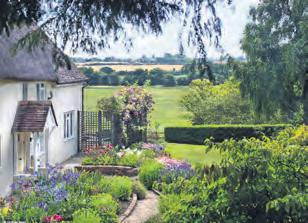

Once again beautiful gardens are opening their gates for St Margaret’s Hospice Care this summer, helping to raise funds for its work across Somerset.
The picturesque village of Hinton St George has an open gardens weekend on Saturday 4th and Sunday 5th May, when nine contrasting gardens will be on show, ranging from cosy cottage gardens to elegant courtyards, with water features, fine specimen trees and historic walls. Open from 1pm until 4.30pm each day, teas available. Combined admission £8 for one day, £12 for both days. Assistance dogs only.
Bay House East, Bay Hill, Ilminster TA19 0AT opens for the hospice on Sunday 19th May, 2pm-5pm. This sloping garden has vibrant and fragrant plants, a tranquil pond nestled amidst the greenery, a productive greenhouse and small vegetable garden, brimming with fresh produce.. Admission £3.
Bedrock Barn at Brompton Ralph TA4 2RT, near the town of Wiveliscombe, also opens for St Margaret’s Hospice on Sunday 19th May, 2pm-5pm. An enchanting garden oasis, with vibrant rhododendrons and azaleas, silver birch trees, three ponds and a wildflower meadow, and views of the distant Quantocks; cakes and cream teas available under a marquee, serenaded by a cellist. Admission £5, teas available, plants for sale, dogs allowed on leads, limited wheelchair access.
For more details about other gardens opening in 2024 for St Margaret’s Hospice, pick up a leaflet at one of their charity shops or go to www.st-margarets-hospice.org.uk and follow the links.
Organic gardens now open three days a week until the end of October

Yeo Valley opens up for the new season
Yeo Valley Organic Garden has reopened for the new season with blossom, bulbs and buns a plenty. The visitor opening days for the popular North Somerset gardens are most Thursdays, Fridays and Saturdays until the end of October from 10am to 5pm.
‘Garden Masterclass’ are returning with some more garden topic based events. ‘Garden Masterclass’ aims to create a place to learn, and to share experience, knowledge, skills and ideas in gardening and landscape design.
On May 1st, the charming and award winning garden designer Annie Guilfoyle will running a workshop at the garden. Details on www.yeovalley.co.uk
Yeo Valley Gardens , Rhodyate, Blagdon, Bristol BS40 7YE
Fortnightly garden waste collection ready for sign ups
Somerset residents are being reminded that they can sign up for a fortnightly home garden waste collection.
The service run by Somerset Council has more than 56,000 subscribers and with spring is the perfect time to sign up.
Subscriptions can be started any time during the year and the quickest and easiest way to subscribe is online through the somerset.gov.uk/waste page – just use the ‘Do it online/My Waste Service’ feature.
Collections are made fortnightly year-round (apart from a short break during Christmas and New Year).
Residents can either sign up to a pre-paid 180-litre wheeled bin or 90-litre compostable paper sacks. The
HARDY PLANT SOCIETY APRIL PLANT SALE
price of a wheeled bin subscription is £63.50 for 25 collections and for packs of ten garden waste sacks, £31.10.
All the garden waste stays in Somerset, going to one of several composting sites, including Dimmer and Walpole, where it is shredded, and turned into compost. The end-product is sold as revive soil conditioner through all recycling sites.
Home composting is the recommended option for garden waste and those who have space to do so can order a subsided home composting bin from the council’s partner Get Composting. Garden waste can also be taken to any one of Somerset’s 16 waste recycling sites.
Garden waste should not be put out for collection with refuse.
The Somerset branch of the Hardy Plant Society are holding their popular Annual Plant Sale at West Monkton Village Hall, Monkton Heathfield, Taunton (half a mile up the road from Monkton Elm Garden Centre) on Saturday 27th April, from 10am to 12.30pm. Entrance is £1, there is free parking and refreshments are on sale.
There is a large selection of mostly hardy perennials at reasonable prices, including some unusual varieties, sold by the members of the group as well as some specialist nursery stalls.
MAY DELIGHTS AS GARDENS OPEN FOR
NGS
One of the loveliest months in the garden, when everything is freshly blooming, May is a wonderful time to visit some of the beautiful gardens opening for the National Garden Scheme while helping to raise much needed funds for nursing and caring charities.
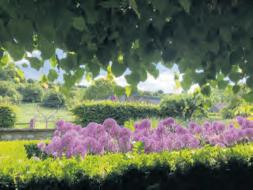
WICK GARDENS, at Wick, Langport, Somerset, TA10 0NL is a new opening for the NGS in Somerset on Saturday 18th and Sunday 19th May, from12pm until 5pm both days, four gardens in close proximity with structure yet informality, lovely planting and much colour, including Wick Manor and Wick Farm. Three gardens are on old sites and one modern garden has been converted from a concrete farmyard. All worth exploring in this delightful village. Combined admission £6, children free, light refreshments available and plants for sale.
1 SUNNYSIDE, Stoke Bishop, Bristol, Somerset, BS9 1BQ, a 17th century cottage in the heart of Stoke Bishop with part walled, cottage style front garden, sculptures, large magnolia, perennials, roses and courtyard garden with open studio, opens for the NGS

on Sunday 19th May with 4 Haytor Park, Bristol, Avon, BS9 2LR that’s full of unusual objects forming screens and plant supports, seats and secret paths, with spaces for unusual plants and wildlife. Kids find the dragons for a prize!
Open 1pm-5pm, combined admission £5, children free, homemade teas.
Another new opening for the NGS Saturday 25th and Sunday 26th May, THE MANOR, South Street, Wincanton, Somerset, BA9 9DL is a hidden and unexpected large walled garden in the town centre around a 17th century manor house. Yew hedges provide structure and divide the garden into distinct areas, with a formal pond garden, vegetable garden with box edging, orchard and tiny ‘lockdown’ garden created in 2020. Open 10.30am-5pm, admission £7, children free, with homemade teas available, wheelchair access and dogs allowed on short leads.
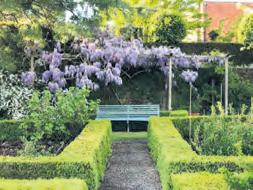
Street getting ready for annual plant sale
Street Chrysanthemum, Dahlia and Vegetable Society is holding its Annual Plant Sale on Saturday 18th May from 8am till 1pm in the library gardens, Street BA16 0HA. There will be a great selection of plants including, chrysanthemums, dahlias, perennials and a large selection of vegetable plants.
For more details see their website www.streetcdvs.org.uk
www.countrygardener.co.uk


5
CUTTINGS
Spring Bedding Plants available Order your Hanging Baskets now Shrubs, Perennials & Alpines Climbers & Trees Logs, Coal & Kindling available Compost & Decorative Gravel Ornamental Pots Find us on Facebook Open every day Godney Road, Glastonbury, Somerset BA6 9AF and at Street Roundabout BA16 OEP 01458 834602 sweetacre@btconnect.com Where quality is higher than the price
Cacti heaven
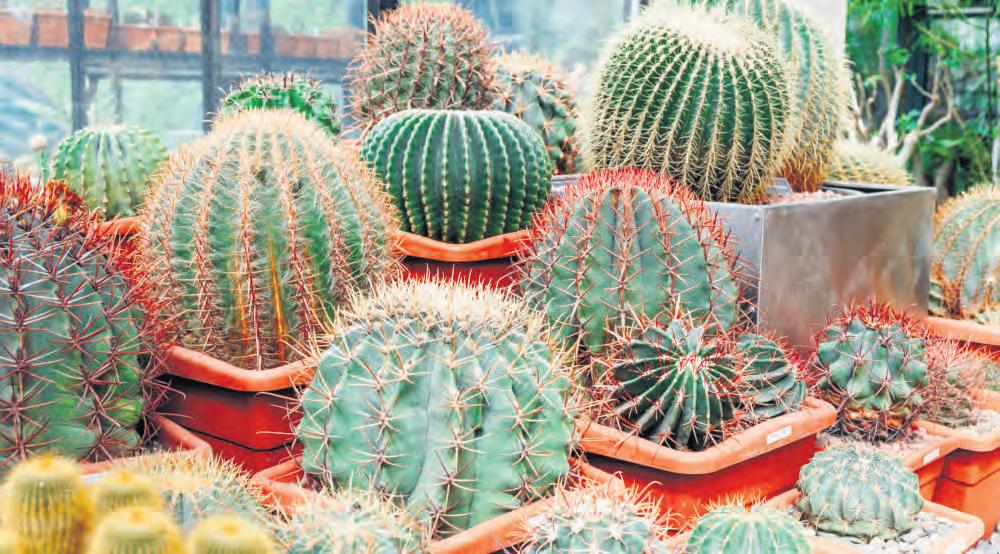
ANNA GREENE HAS BEEN GROWING AND CARING FOR CACTI FOR OVER 20 YEARS AND IS NOW A SELF-MADE EXPERT ON THESE POPULAR PLANTS AND GIVES TALKS AND DEMONSTRATIONS ON CACTI . SHE ADMITS TO BEING IN LOVE WITH THE PLANTS AND KEEPS 40 DIFFERENT VARIETIES IN HER DORSET HOME
I always warn people who want to keep cacti they must remember that the native habitat for most cacti and succulents is a desert.
Therefore, they will grow best in lots of light, good drainage, high temperatures, and low moisture. However, there are some cacti and succulents, such as Schlumbergera, which have a native environment of a rainforest so prefer semi-shade and humid conditions. Caring for cacti and succulents, means trying to recreate their natural habitat.
Light, temperature and ventilation
Cacti and succulents thrive with good light sources, and it is best to place cacti and succulents in a bright place. A south facing position will provide good sunlight. However, be careful to not put them in direct sunlight because the intense light can make the plants turn a yellow colour. The optimum light depends on the variety of cacti and succulent that you are growing. For example, forest-growing epiphytes, such as Rhipsalis, need semishade, but an Echeveria needs bright light.
During the autumn and winter months, it is best for the plants to be kept cool at night with temperatures of around 8°C to 10°C.
Watering and feeding
There is a common misconception that cacti and succulents only require a small amount of water. Even though they have water-storing characteristics in their leaves and stems which allow them to survive in dry habitats, they will certainly not thrive with little water. Watering is an essential part to how well your cacti or succulent grows. Overwatering will stunt growth, but under-watering causes shrivelling.
Tepid rainwater should be used for watering, rather than tap water, as the minerals in tap water build up in the soil and can cause deposits on the leaves.
If your cacti or succulent is pot-bound, then the best time to re-pot is in the spring. To re-pot:
• Firstly water the plant and allow to drain before removing carefully from the pot, using folded paper to protect your hands against the spikes.
• Clear away the old soil from the roots with a thin stick, such as a chopstick, so that you do not damage the roots.
• Put a layer of potting mix in the new pot, which is slightly bigger in diameter, and sit the plant on it.
• Do not water for a few days to prevent rotting of damaged roots. Keeping these conditions gives the best care for your cacti or succulent. Most importantly, remember when it comes to the caring for your plant is that you are trying to recreate its natural habitat!
What are the basic rules of caring for a cactus?
In the growing season, cactuses should be at least watered once a week. When watering, the solid should be soaking, whilst allowing excess water to drain away. Allow the soil to dry out slightly between each watering.
How do you know when it’s time to water a cactus?
When the surface of the soil is feeling dry to the touch during the spring and summer time, it is a good idea to give the plant water.
Should they be kept warm?
Cactuses favour warm, sunny conditions when growing, with low humidity, so they are typically grown indoors in the UK. Cactus plants like an airy and warm spot, a temperature of 18º is ideal for growth.
What are the most common cacti mistakes?
Overwatering is the most common issue many cactuses come up against. Cacti have evolved to thrive in environments with infrequent rainfall, meaning they’re able to store water.
If a cactus has been overwatered, it can cause root rot, stunted growth and make it more susceptible to pests and disease.
How do you encourage a cactus to flower?
Provide plenty of sunshine.Having enough sunlight is completely paramount as your cactus won’t flower in a dark corner with limited sunlight. If you are limited on how much sun you receive, you can always put your cactus under an LED plant glow light to encourage your plant to flower. It can be tempting to plant a cactus in a large pot, but this encourages the plant to grow more roots and growth, rather than flowers. If a cactus is slightly root bound, it will encourage more flowering so it’s important to pot your cactus in the correct size pot.
Make sure you’re choosing a species that grows frequently, as some can take more than 50 years to mature. Gymnocalycium, Parodia, Mammillaria, and Notocactus cacti can be taken care of easily, and flower indoors.
If you want to take extra care of your cactus, you can use cactus fertiliser during the summer months. This is a treatment that will be used once a month to help your cactus thrive and grow. Cacti are a low maintenance plant, but if you want to treat it, fertiliser is the way to go.
Can cactus survive outside in the south west?
There are even some species of hardy garden cactus that will survive outdoors in the UK all year round, but you will have to hunt the variety down.
Echinopsis hybrids can cope with temperatures down to -7°C (19°F). They will require excellent drainage and protection from particularly cold, wet conditions.
Country
6
Gardener



• All year round barbeques and parties
• Children can play outdoors come rain or shine
• Cats and Dogs love the cover
• Patio tables and chairs stay dry - No need to store away for most of the year
• Any colour and any size to suit you and your property
• Supply and install or Supply only
• D.I.Y kits available - Trade Discounts
For a FREE quotation or brochure call 01647 432321 or visit www.allweathercanopies.co.uk


the South West - Somerset show site open for viewing
2024 Opening Times
Mar - 25th Oct Weekdays: 9am - 5pm 28th Oct - 20th Dec Weekdays: 9am - 4pm
Plants, Roses, Shrubs, Herbaceous Perennials, Ferns, Herbs, Clematis & Climbing Plants, Ornamental Grasses, Soft Fruit & Patio Fruit Trees
Gro-Bags, Topsoil, Horse & Farmyard Manure, Soil Improver, Aquatic Soil, Cacti Compost, Orchid Compost, Decorative Bark, Composted Bark, Gravels, Grits & Sands



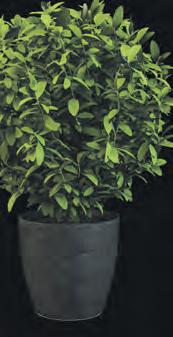

10am - 4pm
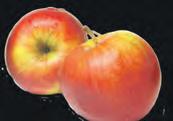

















www.countrygardener.co.uk 7
Covering
WEATHER CANOPIES call Cornwall 01872 470210, Devon 01647 432321, Somerset 01823 729440 or visit allweathercanopies.co.uk GREAT ALL YEAR ROUND ALL WEATHER CANOPIES For a FREE quotation or brochure call Cornwall 01872 470210, Devon 01647 432321, Somerset 01823 729440 or visit allweathercanopies.co.uk MAKE THE OUTDOORS GREAT ALL YEAR ROUND Price Promise Its simple we will never be beaten on price ALL WEATHER CANOPIES VERANDAS - CARPORTS - GLASS ROOMS - PERGOLAS Blaise Nursery Where quality is grown in… Plant Shop
Weekends:
Kingsweston Road, Bristol, BS11 0XF www.bristol.gov.uk Animal, Pet & Poultry Feeds Garden Essentials Composts Bagged Stone | Tools Timber & Fencing Supplies Galhampton Country Store on A359 between Castle Cary & Sparkford, BA22 7BH Open 7 days a week | 01963 440464 Mon-Sat 7.30am - 5.30pm | Sunday 10am - 4pm Garden & Estate Machinery SALES - SERVICE - REPAIRS RIDE-ON MOWERS • LAWNMOWERS BRUSHCUTTERS • CHAINSAWS HEDGETRIMMERS • GENERATORS PRESSURE WASHERS & MUCH MORE BANKSTREET,WILLITON TEL: 01984 632761 READY NOW! Fantastic selection of Summer Flowering Bedding, Hanging Basket & Patio Plants AVAILABLE NOW! Vegetable
Compost,
New selection of
Pots
to
from! Norton Green
Wells Road, Chilcompton, Radstock BA3 4RR Tel: 01761 232137 Email: nortongreenfarm@tiscali.co.uk Opening Hours: Mon-Sat 9am-4pm (inc. Bank Holiday) Closed Sundays NORTON GREEN GARDEN CENTRE
1st
Glazed & Terracotta
& Planters - Lots
choose
Farm Nursery,
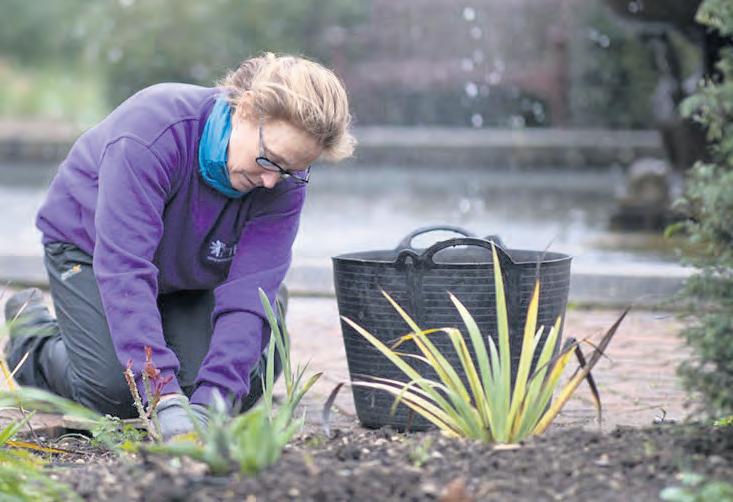
GARDENS CAN WORK WONDERS
Mental Health Awareness Week later in May plans to make the benefits of gardening one of its main points in its campaign and will use west country research to support the findings
Gardens can work wonders when we are stressed and under pressure.
Research which has been studied now for almost 20 years is due to be added to in the next few weeks in the build-up to Mental Health Awareness Week which runs from 13th May to 19th May.
New findings give more support to the belief that gardening, growing and tending plants and being in the fresh air significantly help not just general health issues but mental health problems, which in the UK are reaching record levels.
Much of the new support for the role gardens play in our health comes from the west country, from Devon and new findings in Somerset and Cornwall.
Interviews and studies make clear again that gardens are special places which can improve our wellbeing in many ways, helping us feel calm or giving a sense of purpose.
One of the themes of the health awareness week is encouraging people to spend time outside enjoying nature – an activity which has been proven to enhance and improve mental health and wellbeing.
In fact, a new study involving of 20,000 people many of the interviews being held in the west country found that those who spent less than 20 minutes each day amongst nature were substantially more likely to report good health and improved mental well-being compared to those that didn’t.
Somerset researcher Sue Brownridge who has been working within the NHS on mental health trends said: “ It proves you don’t need to venture far to reap the benefits and beauty of nature! By growing for example your own flowers in the garden, you can enjoy vibrant bursts of colour and floral fragrance, creating a wonderful sensory experience on your doorstep.
“Not only will this contribute to your own mental wellbeing, but it will also be making a difference to biodiversity around you”.
With this year’s theme for Mental Health Awareness Week on moving more for our mental health, incorporating mindful but physical activities like gardening and growing flowers, can help us support our mind and our bodies, while providing vital food and shelter for pollinators and wildlife.
One survey held in Hampshire and Sussex as part of an NHS initiative surveyed over 500 patients and found after a period of gardening:
• 80 per cent reported better mental health
• 93 per cent said their confidence and motivation improved Alongside spending time outdoors, research shows that people with hobbies or projects to focus on are less likely to suffer from stress, low moods and depression. Regularly taking part in activities like gardening gets you out and about and can make you feel happier, fulfilled and more relaxed.
Said Sue Brownridge: “Of course, it’s not a magic wand, but so many people have told us that by getting out and losing themselves in their gardens – and then enjoying all the benefits that come with that – has genuinely boosted their mood levels, wellness and overall positivity!”
• Mental Health Awareness Week runs from 13th to 19th May and this year’s focus is on movement and moving more for mental health. For more information, visit https://www.mentalhealth.org.uk/
• Thrive is the leading UK gardening for health charity, using gardening to change lives. Courses, workshops and general advice is available atwwww.thrive.org.uk
‘How I beat arthritis and can keep on gardening’
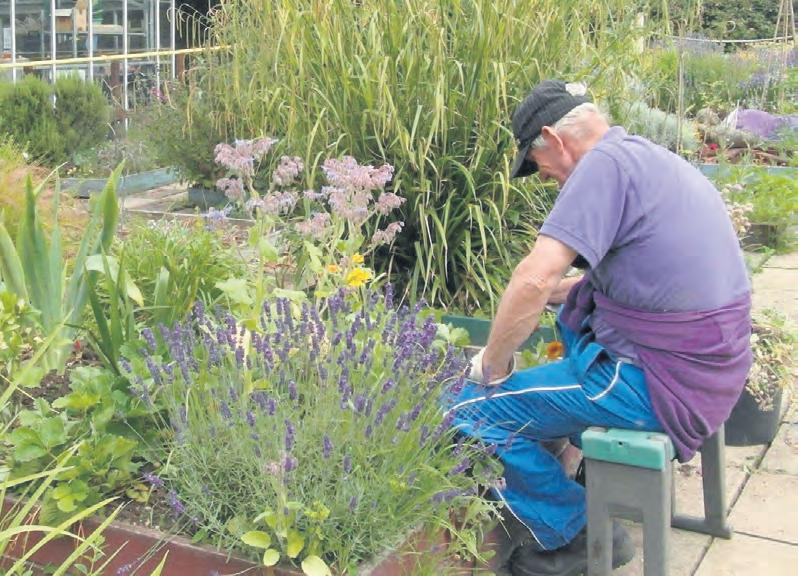
81-year-old Ben Cassidy is still active in his Devon garden thanks to some common sense decisions which meant he was able to ward off the painful affect of arthritis and stay enjoying gardening.
I am 81 and I still love gardening as much as I did 40 years ago.
My great age determines of course what sort of gardening I do but I like to think while I have delegated some of the more physical side of the work needed in my garden, I have more than made up by my creative growing side.
I have green fingers.
I inherited them from my mother and I think her grandmother and growing things has always seemed the most natural thing.
The only thing which is beyond me is the heavy digging. Everything else I can manage, and I do so on wet and windy days just as much as sunny days. My garden is just shy of an acre. There is a lawn. I grow vegetables, have a mini orchard and I am most proud of my borders which in spring and summer are alive with colour.
The reason for my being able to cope with all this and the reason my daughter urged me to write to you is that I have been able to find a way to garden and overcome arthritis which at one stage a few years ago threatened to bring a swift halt to my gardening enjoyment.
Gardening is good for our health and wellbeing and I love being in the fresh air, but painful, arthritic joints, swollen fingers and wrists and stiffness started to hamper what I was able to do.
I now realise there’s no reason to let arthritic joints spoil your pleasure.
I have learnt a few lessons which might help others. It’s nothing dramatic, just common sense.
One big positive for me was changing my garden tools. I bought lightweight varieties with extended handles designed to make cultivation, weeding, pruning and tidying up easier.
I borrowed some from an allotment owning friend and tried them for a few weeks to make sure they felt right and I could manage them.
I found the secret was to exercise my
arthritic joints gently without too much stress. Twenty minutes on any given task was enough.
There are times when I just don’t feel like gardening or have to spend some time resting.
Carefully selected shrubs and herbaceous perennials, for example, need less looking after than a lot of annual bedding plants.
Plants such as bergenias, cranesbill, lavender and periwinkle backed by shrubs such as berberis, senecio, escallonia and viburnum tinus need little looking after once they have rooted deeply.

Special sized tools are a big plus for the arthritic gardener
If your shoulders, wrists and elbows are playing you up it is better to make several trips, carrying a small amount each time.
Planting in containers has made a huge difference. I can work at a comfortable height, especially when I find bending difficult.
I guess I garden sitting down about 40 per-cent of the time. It isn’t as tiring, and you would be surprised at how big an area you can look after from one position.
There are several advantages to gardening while sitting down. The weight on load-bearing joints is reduced and as it is not so tiring you can work longer without discomfort.
Other tips…Keep tools sharp to reduce the effort in cutting. This really does make a difference.
In January and February this year I was like a frustrated child wanting to go out to play. But now I am out in the garden most days.
There has to be a special reason for me not to be out there, working away.
READER’S STORY
8

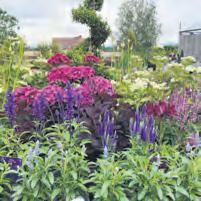


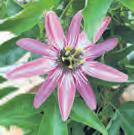

Great range of trees, shrubs, conifers, roses, fruit trees, garden sundries and a wide range of compost.
SPRING BEDDING, PATIO PLANTS, SEEDS, TOMATO & VEGETABLE PLANTS IN STOCK. HANGING BASKETS NOW IN!
Fantastic range of pots and garden ornaments stocked.
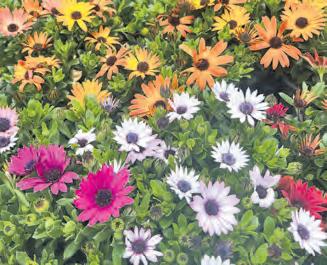
Red Road • Berrow • TA8 2LY
Tel 01278 782687



MSc.Res.Man.(Arb), OND (Arb), F.Arbor.A MARK HINSLEY
We are a Dorset based company offering a friendly, professional tree consultancy service for all areas of the South.
WE SPECIALISE IN:
■ Tree Condition Advice and Surveys
■ Tree Liability
■ Tree
ALL ENQUIRIES WELCOME 01202 876177 www.treeadvice.info
enquiries@treeadvice.info
Former Victorian Walled Kitchen Garden established over 60 years ago. We have an extensive range of shrubs, ornamental and native trees, fruit trees and hedging plants.


✔ Advice / Sales by telephone & email
✔ Extensive website ✔ Carpark collection ✔ Local delivery Opening hours - please see our website
Tel 01984 618267 info@triscombenurseries.co.uk
West Bagborough, Nr Taunton, Somerset TA4 3HG between West Bagborough and Crowcombe (signposted off A358)


www.countrygardener.co.uk 9 The home of quality plants, friendly expert advice & inspiration for your garden & home Quality Outdoor Plants Unusual Houseplants Peat-Free Compost Beautiful Gifts & Cards Seeds & Bulbs Wildlife Care Indoor & Outdoor Pots Potager Café open daily serving breakfasts, lunches, light bites & drinks Follow us on Facebook & Instagram for updates www.cleevenursery.co.uk 138 Main Road, Cleeve BS49 4PW (located on the A390 between Bristol & Weston) 01934 832134 / info@cleevenursery.co.uk Arboricultural Consultants TREE ADVICE & REPORTING
Assessments and Management Plans
Preservation Order Advice
Applications - Advice and Reports (to BS5837 standards)
■ Planning
Triscombe Nurseries
www.triscombenurseries.co.uk
WESTCROFT GARDEN NURSERY & FARM SHOP
•
Carpets made of flowers
by Vivienne Lewis


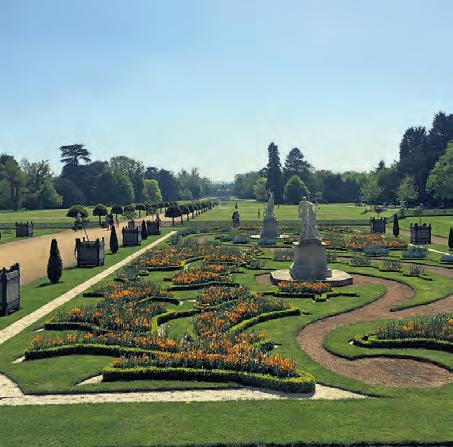
The Victorians loved intricate flower beds made into patterns resembling a carpet, still popular in displays like floral clocks - and one is now being restored after it was cemented over to the dismay of locals and visitors
The floral clock on the seafront at Weston-super-Mare is to be restored after it was cemented over for easier maintenance.
Beloved of locals and visitors, the floral clock had decoratively told the time for decades since its creation in 1935. But it was decided that the flower beds should go, replaced by cement for easier maintenance - it had been taken over by the town’s Lions Club, who found it ever more difficult to keep up. So tidying it up with cement seemed to be the answer.
But residents and visitors were disappointed and angry. There was a protest and the council agreed to break up the cement and restore the flower beds and the clock.
Weston’s floral clock is a survivor of the Victorians’ love of carpet bedding, intricate designs of neat bedding plants in many colours created by teams of gardeners. It is high maintenance work and many of the schemes had to be replaced often during the summer season to keep the colours of the ‘carpet’ going.
A floral clock amazed the public in Paris in 1892, with others soon doing the same in Detroit and Edinburgh (which still has its floral clock). It wasn’t long before municipal parks all over the world were the places to go to get the correct time.
It’s not surprising that carpet bedding fell out of favour, with such high standards of maintenance needed, and particularly with the changing gardening styles in the later 19th century towards a more naturalistic look pioneered by gardeners and writers William Robinson and Gertrude Jekyll.
But in parks and at seaside resorts around the country, in places like Weston-super-Mare, it’s still a favourite feature, with a floral clock at Weymouth, among others.
Carpet bedding also made a comeback at a stately home - the National Trust property Waddesdon Manor in Buckinghamshire now has intricate carpet beds restored on a grand scale.
The Victorians used hardy, half-hardy and tender and exotic plants, neat and kept short, all knitted together so that the overall design resembled a patterned carpet. Sedums and sempervivums became popular plants for carpet bedding designs as they are slow growing, spreading very slowly over time, enabling an intricate design to last while giving a subtle, muted support to more colourful plants to create a tapestry, another name for the designs. The texture of the leaves of these and other foliage plants gives greater interest to the design.
At Waddesdon Manor the design of the formal beds are changed every spring and summer on the Parterre and on either side of the South Fountain. The carpet beds are to the north and south of the Parterre, larger panels of planting where complex designs are used. Each bed is made up of some 26,500 tiny plants, chosen for their compact habit to create a living mosaic. The French name for carpet bedding is ‘Mosaiculture’.
In 2000 an initiative called Art in the Garden was launched at Waddesdon, when a contemporary artist was invited to design the bedding. Now, the garden team create a link between the exhibitions or displays
GARDEN HISTORY
Waddesdon Manor’s ‘pheasant’ on its floral carpet
Knot gardens were a favourite of the Tudors
Country
10
Parterre design at Wrest Park, Bedfordshire
Gardener
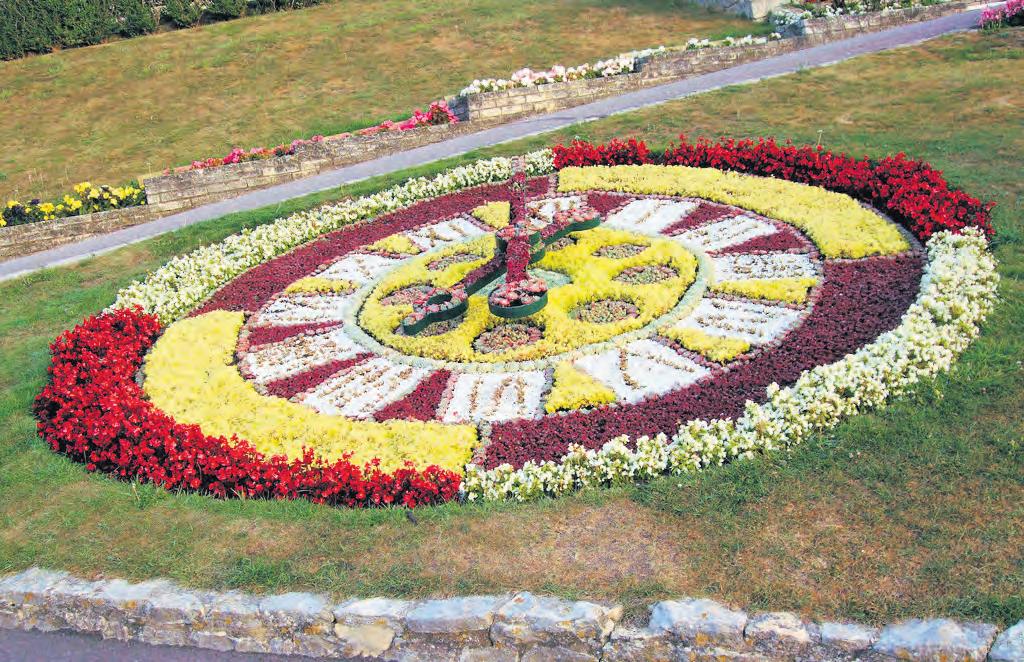

in the house. In 2023 Waddesdon’s carpet bedding was a celebration of the King’s coronation.
Waddesdon Manor was the home of Ferdinand de Rothschild. His sister, Miss Alice de Rothschild, was a passionate gardener. She was known to carry a weeding tool everywhere, and pioneered new gardening techniques at Waddesdon. One of these was the newly invented concept of three-dimensional carpet bedding, where sculptures in plants are used, similar to topiary. An example can be seen with the Pheasant near the Aviary Garden, a sculpture of a pheasant in vibrant planting.
Carpet bedding and the old knot gardens
Carpet bedding design was inspired by the old knot gardens of Tudor times, and also by the embroidered patterns of 17th century parterres. Designs used in weaving, embroidery, carpentry and plasterwork were replicated with plants in the garden to make knot gardens, and old illustrations show how complicated the patterns could be.
Tudor knot gardens often used herbs such as pennyroyal, a type of mint, thyme and rue, marjoram, lavender and hyssop. Unlike the Victorian style of carpet bedding, plants used in Tudor gardens were often taller and allowed to grow, with the pattern created by paths and coloured stones, rather than the plants densely planted together to make the pattern.
The designs of parterres followed on from the knot gardens. Parterre designs became even more elaborate than the knot gardens, and used more flowers than herbs. At first there was not a great difference but as the 17th century progressed the knot garden went out of fashion and was seen as belonging to the bygone Elizabethan age.
The French word ‘parterre’ is a clue, meaning to be


divided, and there was a lot of French influence, and European influence generally, on these designs. Books of the time gave detailed instructions on how to lay out gardens with fancy compartments and alleys, getting away from the old ‘knots’. The phrase ‘parterre de broderie’ describes the fashion for ever more elaborate designs, replicating embroidery on a piece of cloth with borders of flowers, often still using coloured stones to fill up the shapes, with neat paths in between.
Fashions in gardening go in cycles as with any other form of design, and so after the landscape gardens of the 18th century with designers such as ‘Capability’ Brown replacing the old formal gardens with lakes and swathes of grass, there was a move back towards flower borders.
Starting in the early 19th century, flower beds became increasingly important in gardens, until the carpet bedding design became very popular.
Carpet bedding became so popular it became a part of garden design in domestic gardens, not only in public parks and spaces. Wealthier households could afford to enjoy complicated carpet beds and there are old photos showing them - but as gardening became an ever growing pastime some gardeners tried to replicate some of the schemes in their small gardens.
Many of the gardeners who worked at gardens big and smaller went off to fight in World War I and many of them did not come back. Gardens became increasingly difficult to maintain, and either were simplified or as in the case of the gardens at Heligan in Cornwall, gradually fell into neglect. Carpet bedding fell out of fashion, not only for its upkeep, but because the fashion changed once more.
So floral clocks as at Weston-super-Mare and Weymouth are rarities, but it would be sad to lose them forever.
Weymouth’s floral clock, created in 1936, is a landmark at the seaside resort in Dorset. It stands in Greenhill Gardens that slope up from the beach and promenade. The clock with its cuckoo chime is operated by a clock house located nearby, which was restored in 2023.
Carpet bedding is important at Greenhill Gardenseach year a large crescent shaped bed is given over to a charity or organisation who is celebrating a significant anniversary. Gardeners painstakingly plant out thousands of tiny bedding plants and where necessary, use coloured gravel to replicate the selected organisation’s logo.
Did you know?
Carl Linnaeus, the great Swedish botanist, is most famous for creating the system by which we we classify our plants but in 1748 he also devised a 24 hour floral clock of a different kind to the later floral clocks with their actual time keeping mechanisms among the plants.
He began to investigate biological rhythms in plants and wondered if it would be possible to use that to tell the time with any degree of accuracy. In 1751 he wrote Philosophia Botanica, and listed 46 plants – sometimes known as “dial flowers” – that could be used, most of them wild flowers, if not weeds, to many gardeners.
His university at Uppsala has details and illustrations on its website: https://www.botan.uu.se/our-gardens/thelinnaeus-garden/our-plants/life-cycle-of-theflowering-plants/
www.countrygardener.co.uk 11
Images clockwise from top left: Floral clock at Weymouth, The floral clock at Weston-super-Mare, Weston-super-Mare’s floral clock border cemented over, Victorian-style carpet bedding in vogue again at Waddesdon Manor
The weather in a MAY GARDEN
Weather historian and lover of folklore Andrew Lancaster enthuses about the arrival of May and looks at what the month can offer weather-wise to the gardener and the work in the garden
There is something about the month of May. I have never been able to really work it out. For me it is a mixture of emotions.
It makes me happy as it fast tracks us towards summer. But I can hear my father’s voice in my ear warning me that May is the month when everything in the garden grows at its fastest and if you are not ahead of things in terms of planting and sowing then you are in danger of missing out.
So May has things about it to worry me.
As bulbs fade and herbaceous borders grow in leaps and bounds, one thing becomes clear in early May -it is that summer is approaching.
Sowing and planting out bedding can begin, depending on regional weather variations, and you can take softwood cuttings. Spring started five or six weeks ago and although wet and windy nature has been awake for a while now.
Tender plants should be safe in May and maybe they will, but the wise gardener will keep an eye on the weather forecast. I remember last May we had two successive nights of frost and I worried about my summer bedding plants but I just about got away with it. May is the month when all plants start growing rapidly, resulting in lush, immaculate leaves. Everything feels fresh with endless possibilities and as a gardener, there is probably no better feeling than that. Now is the time to care for your seedlings, taking them onto maturity and to get into a rhythm or repeated extra sowings of veg and gradual maintenance around the garden.
By early May my sowing will be over. Everything which needs to be in the ground is. Broad beans are almost ready, the first crop of the new season and in the greenhouse you can almost see plants growing!
Frost can affect many plants and is particularly damaging to tender new growth and blossom in the spring. The risks of frost damage can be reduced by taking some simple steps to protect the plants in your garden.
Asparagus the vegetable for May
It’s a tradition that you should not harvest any asparagus spears until the third spring after planting. The idea is to allow the plants to build up their strength before you harvest in May. It is worth the wait.
If you’ve never tried asparagus before, May is the month to do it. Shops will offer it all year long, but from late spring to early summer, asparagus shines. Its stalks are tender and sweet this time of year. The six-week season is traditionally from the beginning of May to mid June.
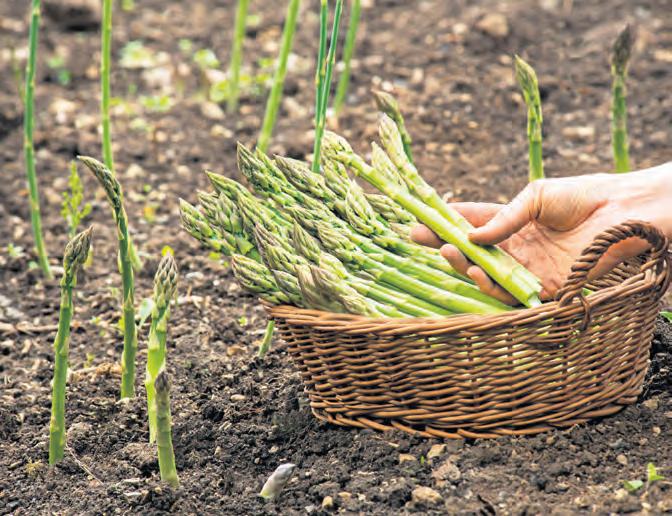
There is a lot of mystery surrounding growing asparagus, but it is relatively simple. It needs a patch in the vegetable plot all to itself. It is a perennial and will be happy to grow in the same spot for years. It needs well cultivated soil and plenty of well-rotted garden manure. The easiest way to plant is to take out a shallow trench and space out the crowns before backfilling with soil.
‘Ne’er cast a clout’
We have all heard the old English saying “Ne’er cast a clout till May be out”, but there are actually two meanings behind the phrase and its origins are unclear.
The word clout is an Old English word for clothing with the saying serving as a reminder to not be quick in chucking or putting away winter woolies until May is out. But is it the May part of the saying that causes confusion.


According to poems published in 1855 in the Whitby Gazette as well as the Farmers Almanac the saying suggests for people not to dispose of any winter clothing before the cooler days during May were over.
However, although poems say this, English farm-workers would often suffer from heat exhaustion during May if they were still wearing their winter clothes. Therefore, the flowering of the hawthorn was used as a guide as to when the winter clothes could be forgotten.
Therefore, the saying “Ne’er cast a clout till May be out” can come with two meanings. One which relates to the end of the month and one that takes the blossom of the hawthorn into consideration.
The origins of May Day are joyful beginnings
The earliest known May festivities hark back to the Roman day Floralia, celebrating Flora, the Roman goddess of flowers.
Competitions, performances and a sacrificial event were held in her name.
This was part of a larger triennial celebration for the gods Dionysus, of wine, and Aphrodite, of love.
In the Middle Ages the maypole was used for a dance that symbolised flowering male virility as baskets and wreaths symbolised female fertility.
Neighbouring villages would compete to see who has the tallest trunk.
Later, the day was marked by the Catholic church for devotions to the Virgin Mary, Queen of May, in the 18th century.
 Hawthorn blossom
Asparagus is at its best throughout May
Hawthorn blossom
Asparagus is at its best throughout May
Country
12
Traditional May celebrations are still carried out
Gardener

Garden wildlife in May
• May is the peak of the nesting season for many of our garden birds. It isn’t unusual to see bird tables snubbed for wild food, which is the best for growing chicks, but the adults will make occasional visits to top up their own reserves. Be sure to take it easy on the mowing and trimming back at this time of year. Most birds feed their young insects, and wild parts of our gardens will provide the richest pickings.
• Most of our returning migrants will now be back, depending on winds, and swallows and house martins will be prospecting old nest sites. Finding their mud cups from previous years means they will have more energy for egglaying and gathering food instead of having to build, but don’t be surprised to find other birds have moved in.
• Activity shifts from the outside world to the inner privacy of the nest, and at the same time the spring veil of fresh, new leaves comes up to hide the dramas unfolding within. So, we might see less of our garden birds; but that is merely a sign that the breeding season has reached its most important stages.
• In early May, a good many garden birds will be incubating their eggs. An egg must be heated if the development of the chick is to proceed, and this is achieved, as we all know, by the parent or parents donating their body warmth for a period of time.
• Anyone out in the garden on a May night will probably tell you how noisy it can be. Hedgehogs are often the culprits, for mating and their ‘rut’
• The first brood of bumblebee offspring are all workers ( sterile females). Some will clean or guard the nest while others will forage for nectar and pollen from flowers. From now on the queen will remain inside the nest, her main job being to lay more eggs.
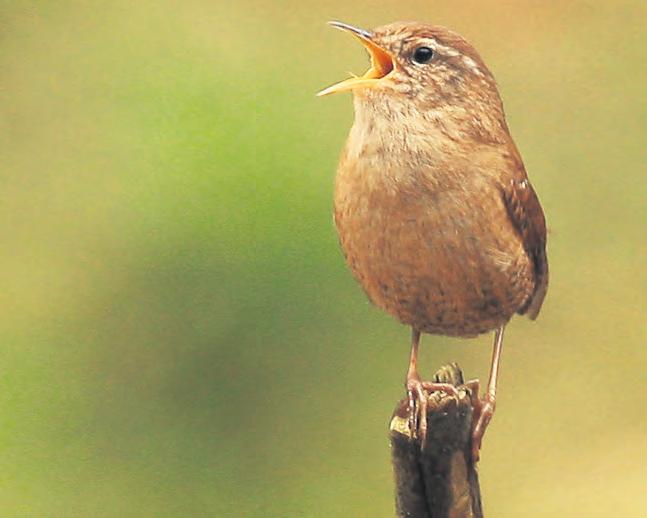
• The dawn chorus is most notable in May a time when birds are defending their breeding territories and attracting new mates. It still feels like night to us, but as birds are perched up in their trees, they can see the sun coming across the horizon before anyone else and this light triggers them singing.
CLEMATIS woes
Clematis is one of the most popular climbing plants, its showy flowers giving an eye-catching display. It is usually an easy plant to grow but can have an aura of mystery surrounding two items in particular: first, when and how to prune and second, a problem of shoots wilting and dying back and various infections.
Some of the shoots on my clematis seem to be dying at the very end. This is a regular occurrence and I am not sure what has caused it.
Unsuitable growing conditions, particularly hot, dry soil, will often result in a weak, unhappy plant that wilts and dies back. Physical damage to the stems ( for example from strong winds or rough handling during tying in of shoots) is also sometimes involved. If your plant is a large-flowered hybrid, then the fungal disease clematis wilt could be involved. This disease is often first to be blamed, but it can be seen from the above that many cases of wilting clematis are not caused by clematis wilt! Many of the species’ clematis are resistant to this disease.

A couple of the stems of my plant have died and if I am not mistaken are giving off a bad smell.
Your plant is affected by a problem known as clematis slime flux, caused when bacteria enter the stem via damage. Slime flux, also known as bacterial slime or bacterial wetwood, is a disease of certain plants and trees. A wound to the bark caused by pruning, insects, poor branch angles or natural cracks and splits, causes sap to ooze from the wound. Bacteria may infect this sap causing it to darken and stain the bark, eventually taking on a foamy appearance and unpleasant smell. Additionally, the fermented sap attracts insects like flies, ants, and maggots.
Treatment is to clean the bark with a soapy or alcoholic solution.
What is the greyish-white growth present on the leaves of my plant?
Your clematis is affected by the fungal disease powdery mildew. To control this problem use an organic sulphur containing fungicide as both preventative and treatment for existing infections. Remove the affected leaves, stems, buds, fruit or vegetables from the plant and discard.
Why won’t my clematis flower?
The most common cause of this problem is poor growing conditions. Clematis need a moist but welldrained soil. The roots need to be kept cool and shaded, but growth and flowering will be impaired if the top of the plant is kept in deep shade. Place stones or pebbles around the base of the plant, or carefully position other plants so that only the base of the clematis is shaded. Try a dose of sulphate of potash in late winter or early spring.

Why is my plant producing flowers with green petals?
Low temperatures during flower development are often the cause of this quite common problem. Pale or white-flowered cultivars are particularly prone to this discolouring, known as ‘clematis green petal’.
If the plant continues to produce green, distorted flowers throughout its flowering period, then a more serious problem known as green flower disease could be involved.

This contagious disease is caused by an organism known as a phytoplasma. Affected plants should be destroyed.
The petals of my clematis are being eaten. What is the culprit?
It could be any one of a number of insects but earwigs particularly partial to clematis flowers, and are the most likely cause. It is a case of monitoring them closely and removing by hand.
Clematis slime flux- a wound to the bark which causes a smelly sap to ooze from the wound
Some clematis will not flower if the roots are kept in the shade and with low temperatures
13
Earwigs are one of the biggest culprits when it comes to eating clematis leaves
AT LAST - the great gardening summer is about to get under way
It has been a long time coming. One of the wettest winters and early springs on record has tested the patience of the most resilient garden lovers.
But despite us still waiting for some warmer weather on our backs, the great British summer is almost with us and with it comes that time of the year for gardeners and garden lovers when there really isn’t enough time in the diary to see and do everything.
May certainly sees the season in first gear with gardens at their freshest, enjoying some of the best display conditions of the year.
It is also time for the great garden days opening for various well-deserved charities from small villages gardens to their grander more baronial versions. And then there’s the great plant and garden fairs which are both so popular and often one the first things to go in any diary of must-see events. They are about to get into full swing. Here’s a few events and venues and dates to make sure you don’t miss out on a great garden day out.
Gardens in historic Cotswold village a joy to see
Visitors can enjoy the atmosphere of this historic Cotswold village and see parts of it not accessible to the casual visitor when Elkstone Open Gardens takes place on Sunday, 23rd June from 2pm to 6pm. There’s the chance to visit the Grade I listed Norman church, the highest in the Cotswolds and renowned for its arches, decorative features, and eco-friendly initiatives. Then amble through a selection of beautiful gardens, enjoy cream teas, homemade cakes, or ice creams, and visit the special plant stall. All profits raised will support the church and village hall. Parking is free. Adults £7.50, children under 16 free. Support dogs only in the gardens. www.elkstonevillage.com
NOSTALGIC EXHIBITION OF IMAGES ASSOCIATED WITH THE BISHOP’S PALACE GARDENS

There’s a touch of nostalgia about an exhibition which runs at the Bishop’s Palace in Wells until the end of July. The exhibition will be A Glimpse into the Past: The History of The Bishop’s Palace Garden and includes items bequeathed by previous bishops and acquired over the decades. Additional items are scheduled to be added soon. Exhibitions within the Palace building are included with any valid entry ticket to the Bishop’s Palace and gardens, including The Bishop’s Palace admission ticket and membership. The palace building, gardens and award-winning Bishop’s Table café will also be open. This event is included with the 12-month admission ticket and membership.
The Bishop’s Palace and Gardens, Wells BA5 2PD
Cerne Abbas ready with 25 gardens open over June weekend
In 1974 Cerne Abbas opened a few of its private gardens to raise money for a good cause. Fifty years on and 48 openings later and around 25 private gardens will open to welcome the public once again.
The gardens will be open on Saturday, 15th and Sunday, 16th June from 2pm to 6pm. The proceeds will be divided equally to support an archaeological dig in Cerne and the restoration of the ancient church in Godmanstone. Entrance to all gardens is by a single ticket which costs £8 for adults. Accompanying younger folk under 16 are free. A few gardens are accessible on wheelchairs and most gardens accept well behaved dogs on leads. There is a well-regarded plant stall and teas are provided by the local youth club, both commencing at 1pm. Almost all gardens are within easy walking distance of the free car park and are located on maps distributed with the ticket. More information on www.cerneabbasopengardens.org.uk

Enjoy the charm and elegance of Kelmscott Manor
Kelmscott Manor was the iconic country home of William Morris, father of the Arts and Crafts movement.
Today, visitors will find an outstanding collection which spans over 300 years and reflects the lives, ideas, and creative legacy of those who lived and stayed there.
The domestic charm and ambience of the house is still retained and having influenced Pre-Raphaelite art and design and the Arts & Crafts Movement, its legacy is still very much treasured today.
Kelmscott Manor also boasts enchanting riverside gardens and the River Thames is located just a few hundred yards away.
For more information visit kelmscottmanor.org.uk
Kelmscott Manor Kelmscott, Lechlade GL7 3HJ
THREE GREAT RARE PLANT FAIRS IN MAY
Following on from a busy start to the Plant Fairs season, the programme of specialist plant fairs continues in May with three great events. The first is set in the gardens of Salthrop House, the home of designer Sophie Conran, at Wroughton, near Swindon, on Sunday, May 12th. The second is in the unique grounds of the American Museum and Gardens in Bath, on Sunday, May 19th. The third and largest is at Kingston Bagpuize House near Abingdon, on Sunday, May 26th, in support of local charities SeeSaw and Riding for the Disabled.

The fairs host a great selection of specialist nurseries, including several National Collection holders who are experts in the plants they grow. Interesting and unusual plants will be available to buy, including choice perennials; plants for shade; rare climbers; alpines; cacti, succulents and houseplants; herbs and edibles; and a great selection of unusual shrubs, all accompanied by the expert advice that you need to select and grow the right plants for your garden.
There are 13 fairs in 2024. Visit the website at www.rareplantfair.co.uk for full details of all the events, including lists of the exhibitors attending.
WHATLEY MANOR HAS JUNE OPENING FOR NGS
Whatley Manor, near Malmesbury, is taking part in the National Gardens Scheme and will be opening their gardens on Wednesday 5th June,welcoming visitors from 2pm till 6pm. The gardens are accessible and dogs on short leads are welcome. House made refreshments will be available to purchase from The Loggia Garden. £8.50 is the entry fee into the gardens which goes towards raising much needed funds for the chosen charities including; MacMillan Cancer Support, Hospice UK, Carers Trust, The Queen’s Nursing Institute, Parkinson’s UK and Marie Curie. www.whatleymanor.com
Whatley Manor,Easton Grey, Malmesbury SN16 0RB
Lukesland offers banks of azaleas and rhododenrons to admire
Lukesland Gardens, just 10 minutes off the A38 in a hidden valley a mile north of Ivybridge, offer delights for all ages in the month of May. Early on, brilliant banks of azaleas and rhododendrons are luminous against the new green of the beech trees and fill the air with exotic perfumes. Wild blue bells and campions abound by a pretty Dartmoor stream, criss-crossed by many picturesque bridges. Later in the month Lukesland’s well-loved handkerchief trees are spectacular, with their white bracts fluttering in the breeze. For children there is a Plant Hunters trail (with prizes!) and everyone will enjoy the delicious homemade soup and cakes in the Victorian tea-room. Dogs are welcome on a lead. Open Sundays, Wednesdays and Bank Holidays 11am to 5pm till 9th June.
For details go to www.lukesland.co.uk or www.facebook.com/lukeslandgardens or phone 01752 691749


GREAT PLACES TO VISIT
Kelmscott Manor
Salthrop House, near Swindon
Country
14
Gardener




Nestled in the heart of North Devon, Marwood Hill Garden is a hidden gem
Home to four National Plant Heritage collections, this private valley garden spans over 20-acres and showcases three stunning lakes, rare trees & shrubs, and colourful surprises throughout each season. Not only a haven for wildlife, the garden is also the perfect environment to explore and be inspired. Enjoy a day of inspirational and relaxation for the whole family.
Catch up over coffee and homemade cake or a cream tea in the picturesque Garden Tea Room or take a bit of Marwood magic home with you from our Walled Garden Nursery and Plant Sales.

















Enquiries &
Room 01271 342528 Plant Sales & Nursery 01271 342577 e info@marwoodhillgarden.co.uk w marwoodhillgarden.co.uk Marwood Hill Gardens, Marwood, Barnstaple, Devon EX31 4EA Tea Room & Walled Garden Nursery WELL BEHAVED DOGS ON LEADS WELCOME
Tea
30 MAY - 1 JUNE 2024 DISCOVER MORE AT THE ROYAL BATH & WEST SHOW Book your tickets now: bathandwest.com/tickets SCAN HERE www.countrygardener.co.uk 15


Spring at The Bishop's Palace & Gardens, Wells, Somerset
14 acres of tranquil RHS partner gardens, moat, medieval Palace building and award winning Bishop's Table café in the heart of medieval Wells.

Tickets to the Palace and gardens valid for 12 months from purchase on any normal sightseeing day. Purchase on site or online at: www.bishopspalace.org.uk

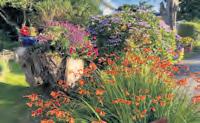










We produce and grow the largest selection available in the UK.
are pot grown and suitable for garden, patio or bonsai. Visitors welcome Mon-Sat 9am-1pm & 2pm-4pm Barthelemy & Co (DCG), 262 Wimborne Rd West, Stapehill, Wimborne, Dorset BH21 2DZ Tel: 01202 874283 enquiries@barthelemymaples.co.uk JAPANESE MAPLES Acer palmatum varieties
Plants
ry BOSCREGE CARAVAN PARK BOSCREGE ● ASHTON ● CORNWALL ● TR13 9TG CAR AVAN & TO URIN G PARK 01736 762231 / 07973 184 42 9 enquiries@caravanparkcornwall.com www.caravanparkcornwall.com Welcometo Boscrege Caravan & Touri ng Park PRI VA TE HO LIDAYHO ME SAND SM AL LRENTALHOMES Perfectforfamiliesand couples OPENALL YEA R With a welcoming atmosphere,set in12
to enjoy
most
sandybeaches in
Praa
acresofCornish countryside, BoscregeCaravan & TouringPark isthebest place
your Cornishholiday Only2.2 miles from one of the
beautiful
Cornwall,
Sands.
16
Country Gardener
LEESA’S ALPINES GET READY TO MEET AND GREET IN BUSY MAY
Leesa’s Alpines is a small independent nursery based in Dorset growing garden worthy alpines and perennial plants which can be purchased via mail order and plant fairs only.
All their plants are grown in a reduced peat compost in a polytunnel initially but moved outside as early as possible to ensure their hardiness.
Alpines (or rockery plants) are hardy perennial plants suitable for many situations in the garden. Although ideal for traditional rockeries and crevice gardens they can also be used for containers, stone troughs and sinks as well as pots, with many species being used to edge borders and pathways as they benefit from well drained soils, many being extremely drought tolerant.
Leesa’s Alpines will be exhibiting at the following venues in May:
BBC Gardeners World, Beaulieu - Friday 3rd to Sunday 5th May
Yarlington House, Wincanton - Saturday 11th May
Athelhampton House, Puddletown - Sunday 12th May Sculpture by the Lakes, Dorchester - Friday 17th and Saturday 18th May
Bryanston Summer Craft Garden and Food Fair, Bryanston School near Blandford - Saturday, 25th and Sunday, 26th May
Sherborne Castle Country Fair - Monday, 27th May leesasalpines20@gmail.com or visit www.leesasalpines.co.uk
Colour is everywhere at Marwood Hill Gardens
Colour is everywhere this month. The spring flowering shrubs are in full bloom with carpets of bluebells covering the ground. The start of the candelabra primulas are a welcome sight around the lakes and stream in a whole kaleidoscope of colours.
The wisteria pergola is draped with the colourful racemes of flowers from the 12 different forms with blue, lilac, pink and white flowers creating a tunnel of magic beside the tearoom where you can enjoy a delicious cream tea with the speciality ginger scones. All our meals and cakes are homemade, so not only are the delicious but they are also from local suppliers and fresh.

The plant sales area is now full of colourful interesting plants. Virtually all propagated from plants in the garden including some unusual and rare ones unique to the gardens at Marwood Hill Gardens, so come and have a wonder around… Marwood Hill Gardens, Nr Guineaford, Barnstaple, North Devon EX31 4EA Tel: 01271 342 528 www.marwoodhillgarden.co.uk Email: info@marwoodhillgarden.co.uk
NGS HAVE A 2024 TREASURE TROVE OF GARDENS FOR VISITORS TO ENJOY
There’s a treasure trove of gorgeous National Garden Scheme gardens just waiting to be explored in 2024. As well as the traditional country gardens that have supported the National Garden Scheme ever since our foundation in 1927, today the gardens represent the glorious kaleidoscope that makes up today’s diverse garden landscape. With almost 3,500 gardens, including 908 new and returning gardens, the year ahead is bursting with horticultural promise. And it’s never too early to start planning your garden visits or to book a special event.
Find your perfect garden: ngs.org.uk


GARDENS & TEAROOM
Open every Friday 2pm - 5.30pm from 3rd May to 27th September

Also last weekend in May & August Bank Holiday weekend - Sat, Sun & Mon
GARDENS: adult £5, child £1
CADHAY, OTTERY ST. MARY, DEVON, EX11 1QT 01404 813511 www.cadhay.org.uk Member of Historic Houses

Hartland Abbey & Gardens

Visit this stunning family home with its fascinating collections and exhibitions

Beautiful walled, woodland gardens and wildflower walks to the beach. Enjoy our ‘William Stukeley – Saviour of Stonehenge’ exhibition. See where Enid Blyton’s ‘Malory Towers’ is filmed.
* Dogs welcome * Holiday Cottages *
* Delicious light lunches & cream teas * House, Gardens etc and Café open until 3rd October Sunday to Thursday 11am - 5pm (House 2pm -5pm last adm. 4pm)
For more information and special events see www.hartlandabbey.com
Hartland, Nr. Bideford EX39 6DT 01237441496/234
Cider, cheese and cooking demonstrations at the Royal Bath & West Show
The Royal Bath & West Show returns from 30th May to 1st June, with plenty to delight food lovers.
The Great British Kitchen returns, with this years’ freeto-attend cooking demonstrations provided by Clodagh McKenna, Rosemary Shrager, and Andy Clarke.
The British Cider Championships will also be judged during the show, with demonstrations of cider-making, tutored cider-tasting sessions, displays of the latest cider-making equipment, and expert advice on tap.
With all this and plenty of cheese and food stalls in the expanded Food & Drink marquee, there will be plenty to tickle the tastebuds of gastronomy fans.
To book tickets, visit www.bathandwest.com



GREAT PLACES TO VISIT
www.countrygardener.co.uk 17
Tulips start to show off their full glory at Forde Abbey
It’s official! The tulips have started to make an appearance in the gardens of Forde Abbey on the Somerset and Dorset border and they are looking exceptionally beautiful. The display is one of the highlights of late spring in this popular garden. The multitude of shapes and shades are a delight. The display is just part of a busy programme of events at the gardens near Chard. Until the end of October the gardens are open from10.30 am to 5pm with last entry at 4pm. Visitors who want to tour the house should not the house opens at 12pm until 4.30 pm The coffee shop will be open throughout the day serving hot drinks, light bites and homemade cakes. The awardwinning gift shop with some souvenirs will also be open, The abbey’s in-house plant nursery is also open from 10.30am. All the plants are grown at the abbey.
The gardens will remain open until 5pm (last entry at 4pm)
Ford Abbey, Chard, Somerset TA20 4LU

FONTHILL HOUSE 2024 Charity Garden Openings
SUNDAY 28TH APRIL
In aid of Seeds4Success (12pm – 5pm)
An amazing youth work charity (please bring cash for the children’s stalls).
SUNDAY 9TH JUNE
In aid of Atlantic Salmon Trust (12pm – 5pm) A charity whose aim is to restore this keystone species & the environment it depends on before it’s too late.
Advance tickets £10 (or £12 on the gate).
Children under 8 years go free.
Variety of wonderful stalls, ice cream van, wine stall, refreshments tent serving delicious things savoury and sweet, tea, soft drinks, etc.
Well behaved dogs on leads welcome.
Unfortunately there is restricted wheelchair access.
Fonthill House, Tisbury, Salisbury
SP3 5SA For more information visit www.fonthill.co.uk/gardens

Barthelemy & Co pedigree Japanese maples specialists
Barthelemy & Co near Wimborne in Dorset was established by a French nurseryman almost a century ago and the Skinner family now specialise in propagating and growing Acer palmatum – or Japanese maples as they’re known.
Throughout spring, summer and autumn the delicate foliage of the acer presents exquisite shadings of Mother Nature’s gold, pink, purple, green, yellow, orange and red. Acers are a delightful addition to anyone’s garden, giving an aura of peace and tranquillity. The ten-acre nursery at Stapehill has a huge collection of Japanese maples to choose from and expert staff are on hand to help select the right variety and to offer advice about caring for the trees in future. Over 100,000 acers are produced at Barthelemy and Co every year approximately 15,000 to 20,000 of them are grafted named palmatum varieties, as one of the largest specialist growers of their kind.
Barthelemy & Co, 262 Wimborne Road West, Wimborne, Dorset BH21 2DZ Telephone 01202 874283 www.barthelemymaples.co.uk

A small independent nursery based in Dorset growing garden worthy alpines & perennial plants. Mail order & plant fairs only.
www.leesasalpines.co.uk
TWO EARLY SEASON GARDEN OPENINGS AT FONTHILL HOUSE
Look out for two charity garden openings at the wonderful Fonthill House, Last year English Country Garden magazine teamed up with the National Garden Scheme to identify the UK’s most popular gardens to visit. Fonthill House garden in Wiltshire, home of Lord Margadale was chosen as a regional finalist.
• The dates are Sunday 28th April in aid of an inspiring local charity, Seeds4Success, https://www.seeds4success.org.uk/,
• Sunday 9th June in aid of an incredible national charity, Atlantic Salmon Trust, https://atlanticsalmontrust.org/.

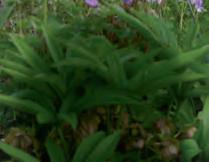

| South Petherton | Somerset | TA13 5HH 01460 240328 | enquiries@eastlambrook.com
Visit the nursery for free without visiting the garden
A visit to the iconic garden of gardening legend Margery Fish is always a joy, never more so than in May when it looks sublime and the nursery is full of tempting cottage garden plants and other interesting and unusual perennials.

Fonthill House Tisbury, Salisbury SP3 5SA

You can wander around the gardens, admire the no dig kitchen garden, browse through the stalls, eat delicious food from the refreshments tent, and even have a glass of wine with your lunch. Lord Margadale will be there to greet you, and the gardeners will be on hand to answer any questions. The gardens have never looked so beautiful despite the wet weather we’ve all been suffering from, so do make a note in your diaries and we hope to see you there. Further details for ticket prices, sales and times, please visit https://fonthill.co.uk/gardens/.







Sunday 23rd June 2024 2 - 6pm
Visit beautiful private gardens, see our very special Norman church, hear the church bells, and enjoy homemade afternoon teas, refreshments, and ice creams will also be available, there will be a plant stall to browse and more.
CarParkfree,Adults£7.50,Childrenunder14free Nodogsallowedingardens
www.elkstonevillage.com
GREAT PLACES TO VISIT
Leesa’s Iconic cottage garden and nursery Open Tuesday to Saturday | 10 am to 5pm Garden entry £7.00 | Children under 16 free East Lambrook
leesasalpines20@gmail.com Alpines
England’s foremost cottage garden JUST 5FROMMINUTES THE A303 AT SOUTH PETHERTON *
PROCEEDS HELP SUPPORT OUR CHURCH AND VILLAGE HALL Elkstone OPEN GARDENS DAY Gardens are good for youvisit an open garden Find your perfect garden:
ngs.org.uk
© Fiona Lea
18
Country Gardener

Boscrege, a breath of Cornish fresh air
Boscrege Caravan and Touring park in Cornwall is a peaceful and picturesque park, set at the foot of Tregonning Hill, Godolphin National Trust and amongst a myriad of Cornish lanes in an area of outstanding natural beauty, The Lizard Peninsular, Helston and Falmouth and many other Cornwall attractions and beaches are easily visited. So if you are looking to take a luxury holiday (doggie friendly with dog friendly homes and on site designated fields for the dogs too) in a either a self catering caravan, lodges touring or even purchasing your own holiday home then contact Boscrege Caravan and Touring Park.
Boscrege Caravan Park, Boscrege, Ashton, Cornwall TR13 9TG Tel: 01736 762231 www.caravanparkcornwall.com
Excitement as Cadhay Manor opens for a new season
Cadhay gardens and tearooms open again on Friday afternoons from 3rd May. It is always exciting to see the gardens coming to life again and the allotment holders have been busy on their plots. Both the gardeners retired over the winter and the new team has taken over with gusto. There will inevitably be changes in the garden as they begin to establish themselves.
Over the winter a lot of work has been done to the borders as you walk down towards the tearoom and a lot of garden walls have been repointed which has given everything a facelift. The gardens open at 2pm on Fridays and will also be open on the Saturday, Sunday and Monday of the last weekend in May (entrance fees for the NGS). For more details see cadhay.org.uk
Cadhay, Ottery Saint Mary EX11 1QT

THREE SPECIALIST PLANT AND GARDEN FAIRS
There are three dates for your diary if you would like to join in a series of specialist plant fairs in Dorset organised by Plant Heritage.
The first of three specialist fairs in will be held on Sunday 12th May at Athelhampton House (DT2 7LG). This fantastic venue is on the large west lawn of a Tudor Mansion House, adjacent to the large Dovecote, formal gardens & the picturesque River Piddle. Athelhampton is easy to find from the A35 Puddletown by-pass. 20 Nurseries have confirmed their attendance.
The second and third plant fairs will be held at Abbotsbury Subtropical Gardens on Sunday 23rd June and Sunday 1st Sept and, as with Athelhampton House, public admission to the fairs is just £7.00 and this includes free access to the attractive gardens for the whole day until 5pm (access to the house at Athelhampton costs extra). Plant Heritage members from across the UK can get in free to the fair with a valid membership card. You will find a very wide range of interesting plants from specialist growers across the South & West, including National Collection Holders. www.plantheritagedorset.org.uk
MAY DELIGHTS AT HARTLAND ABBEY
SUBLIME SPLENDOUR AT EAST LAMBROOK MANOR
The hugely popular East Lambrook Manor Gardens is set to under some changes but it’s still a huge attraction for lovers of a typical cottage garden.
“It’s time for someone younger to take on this famous cottage garden,” says current owner, Mike Werkmeister. “The garden will remain open until a new owner is found and there is no better time to come than May or June when it looks simply sublime.” The Grade 1 listed garden was created in the 1940s, 50s and 60s by Margery Fish, the noted plantswoman and undisputed doyenne of English cottage gardening and made famous through her many books. Since it was first sold in 1985, East Lambrook has had three independent owners who have all restored and nurtured it.
Signature plants such as hardy geraniums, Gladiolus byzantinus, Nectaroscordum siculum, roses and bearded irises abound throughout the garden during May and June. Many can be bought in the garden’s small but excellent Margery Fish Plant Nursery. Garden, nursery and simple café open Tuesday to Saturday, 10am - 5pm. NGS open day on 25th May.
East Lambrook Manor Gardens, Silver Street, East Lambrook, South Petherton TA13 5HH Tel: 01460 240328 www.eastlambrook.com
May is a special month in the Hartland Abbey gardens and walks with an explosion of beautiful wildflowers on the cliffs and the return of old friends to the gardens – the Walled Gardens flourish and become a place to relax and enjoy the peace, magic and scents while the woodland walks entertain with the many newly planted rhododendrons and azaleas along with the old. Sun and warmth will hopefully return after the terrible winter, but if it is wet there is so much to see in the Abbey: The ‘William Stukeley – Saviour of Stonehenge’ exhibition is especially topical after ‘Stonehenge – The Discovery’ with Dan Snow and ‘Malory Towers’ fans will have fun looking for all the filming locations.
Hartland Abbey, Hartland, Stoke, Bideford EX39 6DT
THREE SPECIALIST PLANT & GARDEN FAIRS
Organised by Plant Heritage Dorset
Sunday 12th May 2024
At Athelhampton House, Nr Puddletown, Dorset, DT2 7LG
Sunday 23rd June 2024 &
Sunday 1st Sept 2024
Both at Abbotsbury Subtropical Gardens, Dorset, DT3 4LA
Plant Fairs open 10am – 3pm.
Admission £7.00 includes entry to the gardens (until 5pm).
Free to all Plant Heritage Members.
Many specialist nurseries and growers, including National Collection Holders, large selection of garden stalls plus craft & wildlife stalls. Quality refreshments and food. Free parking. Beautiful locations.
Proceeds support Plant Conservation & Education in Dorset www.abbotsbury-tourism.co.uk/gardens/events www.athelhampton.com/events www.plantheritagedorset.org.uk
48th Cerne Abbas Open Gardens
About 25 Private Gardens Open 15th & 16th June, 2-6pm
Day ticket to all gardens £8 Ticket for 2 days £10 Accompanied children free Open Gardens Teas served from 1pm Well stocked plant stall from 1pm Free Car Park (DT2 7GD) from 1pm
Equal proceeds to: Cerne Historical Society (Abbey dig) & Godmanstone Church Restoration Keep up to date: www.cerneabbasopengardens.org.uk


24 acres of Rare Shrubs, Trees, Pools & Waterfalls
Home-made soups & cakes 10th March - 9th June on Sundays, Wednesdays and Bank Holidays 11am - 5pm
Harford Ivybridge PL21 0JF Tel 01752 691749
www.lukesland.co.uk
May Fairs
12th May
Salthrop House, Wroughton, Nr. Swindon SN4 9QP
19th May
American Museum and Gardens, Bath BA2 7BD
26th May
Kingston Bagpuize House, Abingdon, OX13 5AX


www.rareplantfair.co.uk
Please visit our website for full details of admission fees and times of opening.
www.countrygardener.co.uk 19


Patio Black Spot Remover® works on all types of stone providing stunning, long lasting results.
Go Ferrous, the solution to remove those orange spots caused by lawn fertilisers and rust stains from BBQ equipment, metal pots and plants, without damaging the stone or surrounding plants. Whether buying the product or using our service, prepare to be amazed!
Book now for Summer!

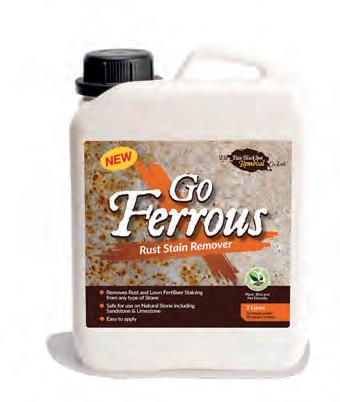







Country
20
Gardener
Order online today or call: 0800 500 3032 Use code COUNTRY at checkout for 10% Discount BEFORE AFTER More Restoration Less Perspiration!
(*product activation time) Completely restore the natural colour to patios and paths of any age, in less than two hours*. Add spring bright colours to your garden! Acacia Dealbata (Mimosa Tree) - available for delivery from as little as £51.95 product code:
A wide range of plants & trees available for UK-wide delivery direct to your door Scan to browse the website! 0203 137 5159 www.gardenplantsonline.co.uk Discounts available for trade customers Garden Plants
www.patioblackspotremoval.com
22728
HAVE YOUR SAY...
If you would like to write to us on any gardening matter, sharing your views, ideas or thoughts then write to us at editorial@countrygardener.co.uk
Gardening and a new lease of life
I’d like to share with you how my father who is 83 seems to have found a new lease of life through gardening. After the death of his wife and my mother. Dad came to live with us in Barnstaple where we could look after him. He was very low and quiet and didn’t seem to be preprepared to do anything with us as a family. My husband had a long trip away on business and the one thing which needed doing was preparing the garden for spring. It was nothing heavy in term of work but meant being outside in the fresh air and buying and planting seeds and doing some planning for the summer. It gave him a new lease of life and he has now taken on the role as head gardener in our garden -giving out ideas to my husband. I know everyone talks about the benefits gardening can have on our health and attitude to life but it has worked wonders for my father.
Eileen Curtis Barnstaple

Home for hedgehogs
A TREE FOR ALL SEASONS
I have a Cornus controversa ‘ Variegata’ in my garden. It is a fine much admired specimen tree benefitting from its isolated positioning. Often these trees are planted up against boundaries or in borders where their true beauty is lost. I initially made this mistake and decided to move it. This species has horizontally tiered branches clothed in white variegated foliage earning its name of wedding tree cake. In summer it produces clusters of white flowers followed with blue- black berries in autumn. Later in summer the leaves turn a pinkish hue while in winter large reddish buds remain. I explain this because it seems to me this is truly a tree for all seasons and one which we should give more attention to.
Jack Salway Southampton
After relocating a compost bin behind a mature bank of shrubs, I was delighted to find a pair of hedgehogs making a home in it. I have now set up a feeding station for them and any friends they might like to join them.
Kay Hall sent by email
A BLACK MARK FOR THE NGS
I don’t want to rake up a thorny old issue, but I am angry. I have just come back from trying to spend an afternoon at one of the NGS gardens open you recommended in your magazine. I have a small poodle, well behaved and eight years old. I have it on a short lead. When I arrived at the garden, I was told "sorry we don’t allow dogs - they can create holes in lawns and beds and trample plants." I made the point my dog doesn’t do that, and it was clear how quiet and placid he is. But no, I wasn’t allowed in with a dog. I certainly wasn’t prepared to leave my dog in the car and left. A black mark for the NGS I think, when compromise should have been possible.
Sally Carter Dorchester
MORE OF US LOVE HOUSEPLANTS
I am delighted to see your magazines is giving more coverage to houseplants.
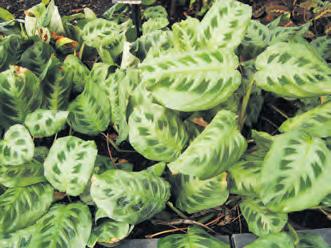
Too many gardening magazines and gardening television programmes for that matter seem to think we all have large outdoor gardens with room for ambitions planting schemes. The fact is there are millions of plant lovers who don’t have a garden but look to houseplants for their growing enjoyment. I for example have a prayer plant ( Maranta leuconeura var kerchoveana) which is much loved and almost 25 years old. It has moved house with me three times from London to Devon to Dorset!
Janet Probyn Lyme Regis

Why oh why plastic flowers?

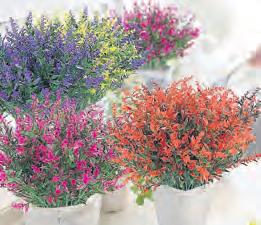
I saw something the other day in a garden centre which I visited with a friend that shocked me. On sale in a prominent position near the till was a display of plastic flowers on sale in plastic pots (and not very cheap either!) At a time when we are all becoming rightly concerned about plastic it seems inappropriate for any garden centre to be adding more artificial plants to their range. I had a chat with the very nice lady on the till who said the garden centre had found over the winter there was real demand for them as they offered all year-round colour! She didn’t see any reason why I should be upset. We should be speaking out against the sale of them.
Kirsten
Wood sent by email
WHAT HAS HAPPENED TO THE FLOWER SHOWS?
Do any of your readers regret the decline in the number of flower shows these days? Once up a time in and around a twenty-mile radius of us there were a whole range of village and small-town flower shows which were a delight to visit on a Saturday afternoon. They all had one thing in common- the celebration of local gardeners and their ability to grow everything from vegetables to fruit and to get the chance to show them off to their neighbours. My father and grandfather used to exhibit in Kent. Not only were there annual and seasonal shows but several of the villages had monthly competitions. My father in particular used to look for opportunities to show off his vegetables (leeks and onions were his speciality and he would travel around the shows).
What has happened to them all? Are there no more gardeners out there? Or can’t people be bothered anymore and have found better things to do. I find it very sad.
Pauline Robb sent via email
Hammering a nail into a tree worked
My husband and I enjoyed your collection of old wives tales in the last magazine. He remembers his father who was a senior gardener at one of the big estate houses in the Cotswolds in between the wars, using the trick of hammering a nail into a tree to bring it to life – an act which he was convinced worked well.
Pam Harrison Bridgwater

LIVING SIDE BY SIDE
I read an article about long life with your house plant recently. When I was in hospital for a cancer operation in 1994 I was given a Clivia by my son which has produced orange flowers every year. The cancer has long gone but my Clivia lives alongside me.
JoJeffrey Ilminster
How I use holly leaves
I have found another use for holly in the garden. I love tulips and in order to have a proper display of the bulbs I must keep several steps ahead of squirrels, otherwise they dig up the bulbs or annoyingly bite off all the buds and flowers. Dropping holly leaves into the holes above each bulb used to work but the squirrels got smarter so now I position holly sprigs over the surface of the soil and then cover them with netting. When the tulip leaves appear I remove the netting and insert stems of holly around the edge of the pot. I am winning the battle against these blessed creatures.
Josephine Griffiths Burnham
READERS LETTERS
21 www.countrygardener.co.uk


Gardeners have voted for the list of most beneficial garden species and the top two come as no surprise when it comes to helping in the garden
They may not look the most healthy and helpful, but lichens have topped the list of the most asked about beneficial garden species.
In second place and close behind comes the aphid munching native ladybirds-perhaps the most well-known useful insect for gardeners.
The list, published for the first time, celebrates wildlife found in gardens and highlights how encouraging biodiversity outdoors can bring benefits which gardeners should encourage and not be concerned about.
Often found growing on trees or shrubs, lichens are superb all-rounders, providing food for other wildlife, shelter for invertebrates and nesting material for birds and mammals.
They only use the bark on the tree as a place to live and grow. They do not penetrate the inner bark of trees, and they take no nutrients or water from the tree. They capture carbon from the atmosphere and soak up excess moisture in wet weather.
Lichens and ladybirds are the tops
Lichens can be extremely long-lived, with some considered to be among the oldest living things on earth.
If you absolutely must remove lichen, then spray lichen with a gentle soapy solution After wetting the lichen, you can use a natural-bristle scrub brush and gently exfoliate the lichen off.
The ranking of beneficial garden wildlife was compiled by gardening enquiries in 2022.
A healthy garden will support several species of ladybird. Ladybird beetles are natural enemies of aphids insects that kill plants. Ladybugs can control insect pests. Aphids are tiny insect pests. They suck the sap from many types of plants such as vegetables, fruits, flowers, and trees.
Ladybirds are beetles in the family Coccinellidae, they range in size from one to ten mm and are round or oval. Ladybird larvae all have a similar elongate body shape with three pairs of obvious legs, most are black or dark grey, some have yellow or orange markings and many have hairs or spikes.
There are more than 40 species of ladybird considered as resident in Britain, about 20 of these are less than three mm big and dark in colour and so often not recognised as ladybirds.
Many ladybirds are predatory feeding on aphids and, scale insects, they can help keep these insects under control.
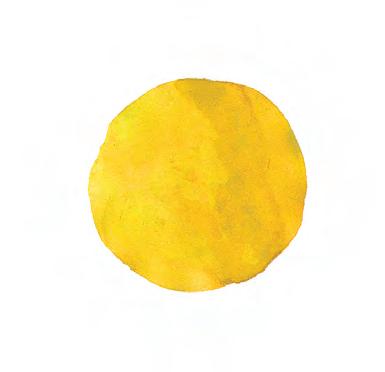









Above left: Lichen may look damaging but only helps wildlife. Above: Ladybirds are great devourers of aphids
Other species feed on mildews and a few feed on plants but none cause serious problems in gardens.
In spring the adults emerge and disperse, mate and lay eggs. Also on the list is the bright green metallic rose chafer beetle (Cetonia aurata) the lava of which help breakdown dead matter. The rose chafer is often seen on flowers in the garden, and is sometimes maligned for munching its way through these plants. However, it is an important detritivore – feeding on decaying matter and recycling its nutrients - and is a helpful addition to any compost heap. Social wasps , often maligned also made the top ten as they are vital garden predators feeding on everything from caterpillars to green fly.
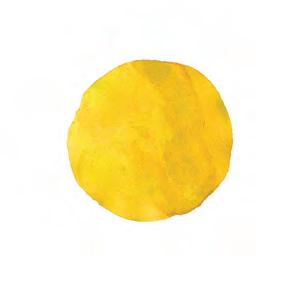






Country Gardener 22 WILDLIFE
Effective against damage expected from... LILY BEETLES
GARDEN ACCESSORIEShelping take the strain
It’s time for the hard work. May is generally acknowledged as the month when there is most which needs doing in the garden and the month where everything grows at its fastest. The borders need tending and planting, the soil needs its annual boost and already plants , shrubs and vegetables need the all-important garden supports. For many gardeners it the most popular month of the year – and one of the busiest. So, a few garden accessories can come in handy.

It’s important to get some help. There are so many products lined up now to take off the hard physical work in the garden that most of us would be crazy not to seek help.
At Country Gardener we are always on the look out for great products and fresh ideas so here’s a few to help take the strain and make the garden even more enjoyable.
Fabulous Bespoke Verandasnow with up to 25% off*
Enjoy your garden throughout the year, whatever the weather with a stylish veranda from Eden and now available with a superb finance deal – buy now, pay later plus you can save up to 25percent off* in our Spring Sale. Constructed from the highest quality materials and bespoke manufactured, an Eden Veranda is a stunning addition to any home. With accessories such as intelligent heating and lighting you can spend more time ‘outdoors’ in comfort. Every Eden Veranda is powder coated with a hard-wearing weather-proof finish, available in a choice of 56 colours and installed by Eden Veranda engineers. Visit edenverandas.co.uk or call 0800 107 2727 and use code CG251123. Order now for summer 2024 installation. *Terms & Conditions apply, see website for details. www.edenverandas.co.uk

New all-purpose growing products from CoirProducts
CoirProducts.co.uk of Salike has introduced a range of new and exciting products for growers and gardeners. Among them is Coir Plus, a coir all purposes compost that comes enhanced with NPK. Crafted from the dust and fibres of the coconut husk, coir is completely natural and peat-free. The addition of essential nutrients of nitrogen, phosphorus, and potassium contributes to healthy foliage growth, stronger root development, and plant vigour. Coir Plus comes in 5kg blocks giving over 80L of coir when hydrated, 1kg blocks giving 15L of coir and 50L coir plus in loose bags. With neutral pH levels, the nutrient-rich Coir Plus is designed for easy growing and is suitable for a variety of plants and crops. ww.coirproducts.co.uk

GROW WITH COIR
Our popular coir packs for children include the My Kid’s Playground Bundle, the My Little Gardener Bundle, and the My Secret Hobby Bundle. Each of these packs contains a variety of sizes of our signature products including CoirProducts CoirCoins, Coir Pots, Coir Discs & an activity booklet.
Crafted from the dust and fibres of the coconut husks, our coir products are natural, peat-free, and biodegradable. For children looking to grow some of their favourite products, we also have specially curated packs with seeds for growing broccoli, carrot, tomatoes, sunflowers, microgreens, and pumpkins.




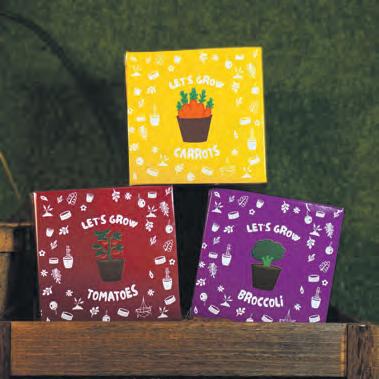
WWW.GROWWITHCOIR.CO.UK
GARDENING WITH
CARBON NEUTRAL BIODEGRADABLE NATURAL PEAT-FREE A PROJECT BY WWW.COIRPRODUCTS.CO.UK, A GROWER’S CHOICE!
KIDS
ACCESSORIES www.countrygardener.co.uk 23
● WIDE RANGE OF BESPOKE DESIGNS, FRAME

● PROFESSIONALLY INSTALLED BY SKILLED CRAFTSMEN ● 10 YEAR GUARANTEE

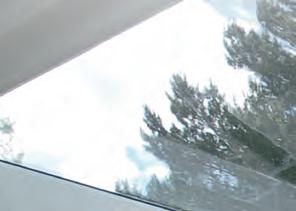
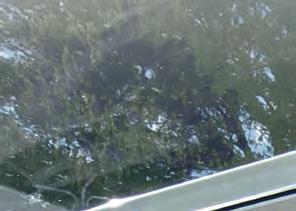



● OPTIONAL ENERGY EFFICIENT HEATING & LIGHTING





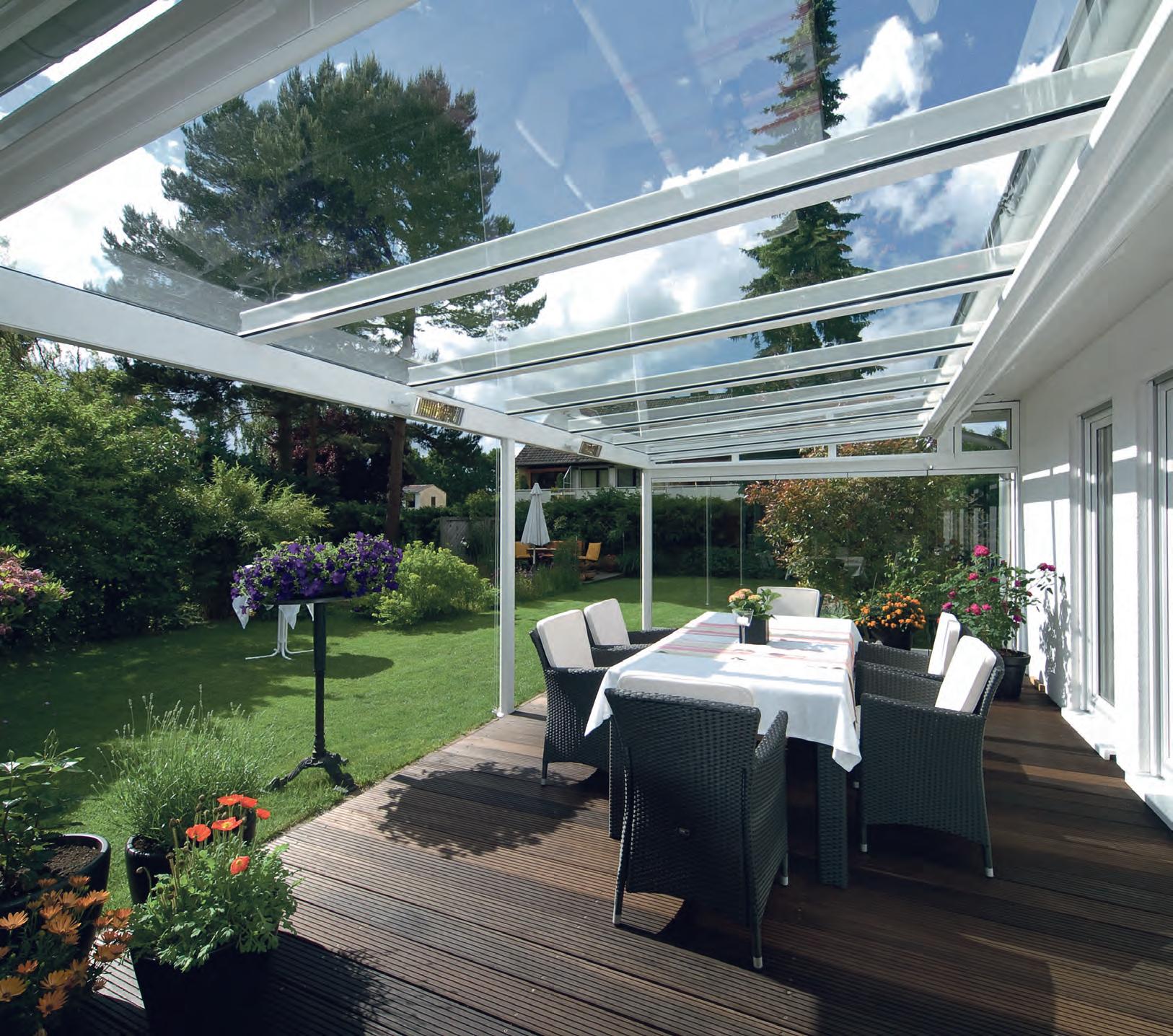

ENJOY YOUR GARDEN ALL YEAR ROUND WITH A GLASS VERANDA
FINISHES
COLOURS & WEATHERPROOF
BUY NOW PAY LATER WITH A 25% DEPOSIT** SPRING SALE NOW ON Call 0800 107 2727 andquote code CG290424 for a free brochure & no obligation quotation, or visit our website edenverandas.co.uk UP TO 25% OFF * Eden Verandas is a trading style of Eden Verandas Ltd. Our registered address is Unit 13 Armstrong Mall, Southwood Business Park, Farnborough, GU14 0NR. Reg. No. 08259394. We are authorised and regulated by the Financial Conduct Authority FRN 801638. We are a credit broker and not a lender and other credit facilities from a panel of lenders. Terms & conditions apply. Credit is subject to status and a ordability. *Terms and conditions apply. **With our Buy Now Pay Later Product you will pay no interest if you repay the loan in full within 6 months from installation. If you prefer you can choose to spread the cost for longer and pay the minimum repayment outlined below at the end of the deferred period instead. Interest is calculated and charged from the date of payout. Cash Price £8000 less a deposit of £2000. You can pay nothing for 6 months (although you can if you wish) then settle the balance by the due date. Total amount repayable £8000. Alternatively 120 monthly repayments of £98.78 with the 1st payment commencing 6 months after installation of the goods. Total Charge for credit £5853.60 Total amount repayable £13853.60 (includes £2000 deposit. 14.9% APR Representative). HURRY! ORDER NOW FOR SUMMER INSTALLATION!



C M Y CM MY CY CMY K CG_FP_Spring_FP.pdf 1 08/04/2024 14:40 www.countrygardener.co.uk 25

High quality plant supports for borders and vegetable plots
Plant Supports (UK) Ltd are a family run business who are extremely proud to be a totally British supplier of robust affordable supports. They manufacture high quality plant supports not only for the herbaceous and shrub borders but also for the vegetable garden.
Keeping the garden pristine has never been so easy thanks to the great range of supports available from Plant Supports (UK) Ltd and should be regarded as an essential investment as the best will last for years.
Order online at www.plantsupports.co.uk or call 01584 781578
SAFE AND EFFECTIVE UNIQUE CONTROLS FOR SHRUBS AND CLIMBERS
You can control your shrubs and climbers using Rivelin Glen Products uniquely designed Wire Anchors. They are quick and easy to attach to concrete posts (without drilling) to act as an ‘eye’ by threading wire through them to create a trellising system.

The Gripple Trellising System is ideal to use with the wire anchors as the wire does not stretch, takes up to 100kg load & has a life of up to 15 years. Multiple rows can be achieved with one length of wire and two tensioners. No more sore hands or sagging wires!
Rivelin Glen Products are the main stockists of the Gripple Trellising System.
Prices: Wire Anchors from £10.00 for a pack of three; Gripple Starter Kit - £19.75
Details available at: www.rivelinglenproducts.com
Email: info@rivelinglenproducts.co.uk or Tel: 01246 462666
A SIMPLE BUT EFFECTIVE GARDENING STOOL TO SAVE BACKS AND KNEES
The ergonomic and functional OneLeg stool, with simplistic and clean lines ,enables you to sit rather than kneel, when completing low-level tasks around the home and garden.
Its rounded base provides a natural ability to rock and tilt as you sit, increasing your reach as you tilt forward, improves your core and saves you from developing a painful back and knees when gardening. Weather proof, impact resistant, lightweight, easy to clean and 100% recyclable, the stool comes in a great choice of colours and two heights, with a free black silicone anti-slip foot. Add a seat cover for extra comfort.
Once you have one you may wonder how you ever lived without a OneLeg. “A game changer! What a brilliant little stool. Can’t wait for gardening to start with a vengeance!” www.oneleg.co.uk 0800 195 4252 oneleginfo@oneleg.co.uk

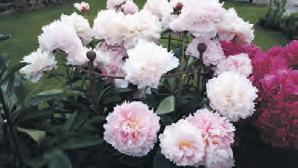








ACCESSORIES
Concrete Post Fixings (Wire Anchors) & Easy Trellising System Quick & Easy Solution to fix wires to concrete posts NO DRILLING - simply clamp the two halves together Three sizes to fit most concrete posts FREE UK DELIVERY Main Stockists of Gripple Trellising Visit our website to view our other gardening accessories and gift ideas www.rivelinglenproducts.co.uk info@rivelinglenproducts.co.uk 01246 462666 Wire Anchor Wire Anchor with Gripple Trellising System PlantSupports(UK)Ltd.Skipperley,Rochford,TenburyWells,WorcsWR158SL with a passion for gardening and we are proud to say PlantSupports(UK)Ltd.Skipperley,Rochford,TenburyWells,WorcsWR158SL Support where it’s needed
26
Country Gardener
Garden advice for May
Another busy early season postbag from Country Gardener readers. If you have a query or a problem you need help with please contact us at Country Gardener, Mount House, Halse, Taunton Somerset

My young fruit trees planted last spring on my allotment have a very scary looking blue beetle on them. Will it harm the trees?
Nick Endersley Poole
This is almost certainly the alder leaf beetle which is very distinctive in its blue colour. Both the adult beetle and the black larvae feed on the foliage of alder and other deciduous trees. They can cause significant damage but trees will normally be able to grow through it and not suffer any permanent growing problems. Treatment isn’t normally available. If as you say the trees are young one option might be to remove by hand.

I seem to get powdery mildew on a whole range of plants in my garden from clematis to honeysuckle and specially courgettes in the veg patch. Is this a garden problem or something which just happens to affect several plants?
Carol Prescott Minehead
Powdery mildew is a disease caused by a group of fungi that affects the foliage of a wide range of plants. The disease is worse when plants experience drought followed by a period of high humidity. Choosing the right plant for the right place is half the problem. The key is also to spot symptoms early on so you can take prompt action to limit its spread. Infection rarely spreads across plant species which helps contain the problem. If it is a small plant affected just try picking off the damaged leaves and dispose of them. Plant hygiene is important so dispose of the damaged leaves carefully. Daytime overhead watering reduces disease if the leaves dry quickly and don’t get wet.

My very young tomato plants already have mauve edges and veining so early in the growing season. There’s also brown blotches and the lower leaves are yellowing. I have still to put them outside. Can they recover or shall I start again?
Geoff Gowling Liss
Early in the growing season even plants that are protected by being under cover can be affected by low temperatures. This spring fluctuation in temperatures can sometimes lead to an alarming degree of leaf curling and damage including discolouration. Fortunately, it isn’t serious, and it usually disappears as the nights get warmer. So no, stay patient and help their recovery by watering regularly, keeping the compost evenly moist and feeding every ten days with a high potassium liquid tomato feed.
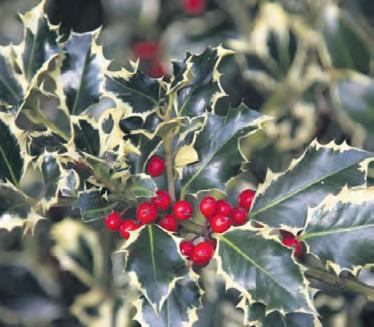

I have an eight year old mature, variegated holly which drops half of its leaves in winter and I worry it is struggling as again this spring it looks as if it needs some help. Is there anything I can do?
Terry Prescott Bath
Like most evergreens, holly will drop its leaves when stressed in some way. Water stress would be the first thing to look at but it would certainly be worth investigating for any indications of pest infestation or disease. Holly is generally quite a tough and resilient species, and a mature one which is eight years old like yours should be established enough to recover from any stress related issues without the need for intervention. If the tree appears to be otherwise healthy then put this down to normal leaf drop. Even evergreens need to discard old leaves to make way for new ones. Provided that the shoots are green and healthy then you needn’t worry - fresh new leaves will be produced to replace those lost.
We have more and more ants in our garden - the lawn has more and more nests. It is becoming a real worry. I use ant powder but it doesn’t seem to work. Ants are I appreciate generally quite beneficial in the garden as they feed on sap sucking aphids and the honeydew that they produce. But I can appreciate why gardeners don’t want them living in the lawn to such an extent as they are now. Karen Simpson Portsmouth
There are a whole range of products on the market from powders to gels that can be used to kill an ant’s nest. Gardeners have had success with the gels in particular so it might be worth trying one of them during a period of drier weather. You can also buy nematodes that are watered onto the area and these are found to be very effective too. You could try the old-fashioned remedy of pouring boiling water over the nest - this will certainly upset them but also tends to kill the grass leaving unsightly bare patches and ants can soon return after such treatment.
The other option is of course, to find a way to live with them. You can reduce the mess made when mowing by raking over and excavating soil mounds on a dry day prior to mowing. If you can encourage birds into your garden, then they will readily dispose of any ants and eggs that are brought to the surface by this process.

YOUR QUESTIONS ANSWERED
TA4 3AD or editorial@countrygardener.co.uk
www.countrygardener.co.uk 27
I am a very enthusiastic composter and have three large bins which are always ‘on the go and I have just emptied one of the bins which was ready to be dug into a flower bed - however I did not find any worms. Does this mean the compost will be less effective?
Harry Balcombe Martock
Worms will only be present in compost if there is a supply of organic matter for them to eat, such as dead leaves, decaying plant material or manure. There are a number of reasons for a low worm count in compost . The bin may have become too saturated with water or too dry for worms to be happy. Also there could be a lack of oxygen in the compost. The fact is the effectiveness of your home grown compost is not likely to be affected too much.
Time to rescue our ponds and water features
WATER FEATURE CONSULTANT ANDREW COOK SAYS TOO MANY GARDEN PONDS ARE BEING NEGLECTED, NEED WORKING ON AND A NEW LOOK
Can you give me any advice on getting rid of fairy rings on our lawn, they are spreading out in ever increasing circles?
Kevin Smythe Burnham

Fairy rings are interesting things. They are caused by a fungus which grows within the roots of the grass. The fungus causes characteristic circles of toadstools in autumn but are visible throughout the year as circular areas where the grass dies back. The spores are airborne so there is little that you can do to stop a colony forming in the first instance. Once a colony forms it begins to spread gradually outwards, dying back from the centre and so takes on a ring like appearance. Incredibly, a colony may spread up to 30cm a year! Fairy rings are not harmful in any way.
In terms of control, there is little that you can do. There are no chemical controls available. Given that the mycelium grows outwards through the soil then in minor instances you could dig out that area of soil (from beyond the outside of the ring, and to a depth of around 30cm) and replace it with fresh topsoil and turf.
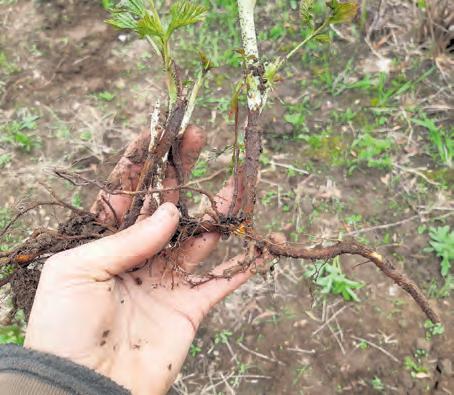
Should I take the runners off raspberry plants and if transplanted do they stay true to parent plant?
Allan Durrant
Bourton
Yes it’s a good idea to remove raspberry suckers to keep the plants within their allotted space. If you would like to use them elsewhere in the garden, then they can certainly be potted up and they will be true to the parent plant. When you remove the suckers try to dig down a little and get some roots. These can then be potted up at the same depth that they were growing in the ground.

I know it may seem rather odd after all the rain we have had but my garden is very dry in the summer and this year I want to see if I can introduce some more drought tolerant plants. Are there any obvious choices? Rex Howe Dorchester
Perennial flowers like dianthus, gaura, thyme, lavender and veronica all do well without much water – and it helps if you look to Southern Europe for ideas on beauties to plant out.
Cabbages, leeks, carrots and parsnips are all good in a drought – they do not require a great deal of attention or watering and will produce well with very little.
Most plants don’t need nearly as much water as we have the habit of giving them in the UK. Herbs and vegetables might benefit from a good soak when you plant them, but their flavour is enhanced when you reduce the amount of water you give them.
We all love garden ponds but it seems that far too many of them are being neglected. Ineffective and damaged pumps, poor linings, unclean water, overcrowded weeds and damaged design features all combine to make it an unhappy start to spring for many water features in gardens.
In some cases, it is a cost issue say experts. In many other it’s just a case of neglect which can be quickly put right.
A pond is an asset in any garden – both an attractive centre piece and a magnet for wildlife. And just like any area of the garden, regular maintenance will help to keep it in good condition and looking great.
“You can’t just leave a pond to look after itself,” says water feature consultant Andrew Cook.
“As we go round gardens it’s clear that while people love their water features too many of them are not being looked after as well as they should.
He highlighted two problems.
“The first is the correct properly functioning water pump, well serviced and the right one for the particular job. The second is allowing weeds to take a hold which then takes a disproportionate amount of time to clear.
“Without regular attention floating weeds and pond algae can do damage very quickly and the amount of work needed to clear everything out takes longer if neglected. Growth can be rapid as the weather warms up. Twirl the weeds out with a stick or scoop out with a net. Leave them on the side of the pond overnight, so larger creatures can return to the water. Rinsing the material in a bucket of pond water can help release smaller creatures, which can then be returned to the pond.
“It’s worth keeping a regular check on your pond and the plants growing in and around it, to make sure everything is thriving and in balance. Pond plants can be quite vigorous, so may need controlling, or perhaps you want to add more. The water quality can decline, particularly in hot weather, and pondlife may need a little help, both in summer and winter.
“But just beware of too much intervention – it can upset the pond’s natural balance and deter wildlife. Ponds rarely need a complete clear-out, unless they’ve become extremely overgrown or silted up.”

Oase pumps find the right pump for the right pond task
Pond pumps are specifically manufactured for different purposes. A pump that is intended to work on a fountain will not produce the right results if you try using it to feed your filter.
Filter pumps are designed to ensure minimal maintenance. The large holes in the casing are designed to allow dirt particles to pass through the pump without clogging it. When pumped to a filter these particles are then removed from the pond system, helping to keep your pond water clean and clear.
In contrast a fountain pump has smaller casing holes to prevent dirt from being drawn in and clogging up the fountain nozzles.
The pump that you casually drop into your pond has gone through years of specialist development and testing before reaching your local store. Find out more about OASE’s range of pumps - https://social.oase.com/ pondpump
YOUR QUESTIONS ANSWERED WATER FEATURE
28

BESPOKE STONE AND SLATE CAN REVIVE YOUR WATER FEATURE AND GARDEN
Welsh Slate Water Features hand craft bespoke natural stone and slate water features and decorative rocks for garden designs and landscaping projects across the UK.
You can choose from an individually selected collection of beautiful Monoliths, Window Stones, Standing Stones and more.
Proud manufacturers of the RHS Welsh Slate Collection, the company work closely with many garden designers and landscapers to create and enhance beautiful outdoor spaces.
Please use promotion code ‘CG10’ for 10per-cent off your order. This is a campaign for Country Gardener readers only. Free delivery is available for most UK Postcodes
Visit www.welshslatewaterfeatures.co.uk for any advice, questions or queries
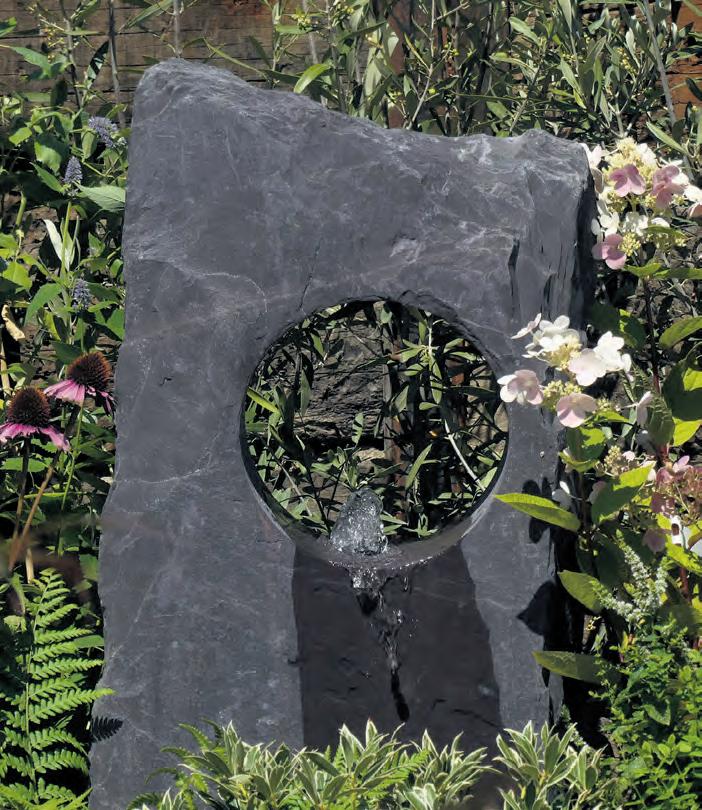
Hand Crafted Natural
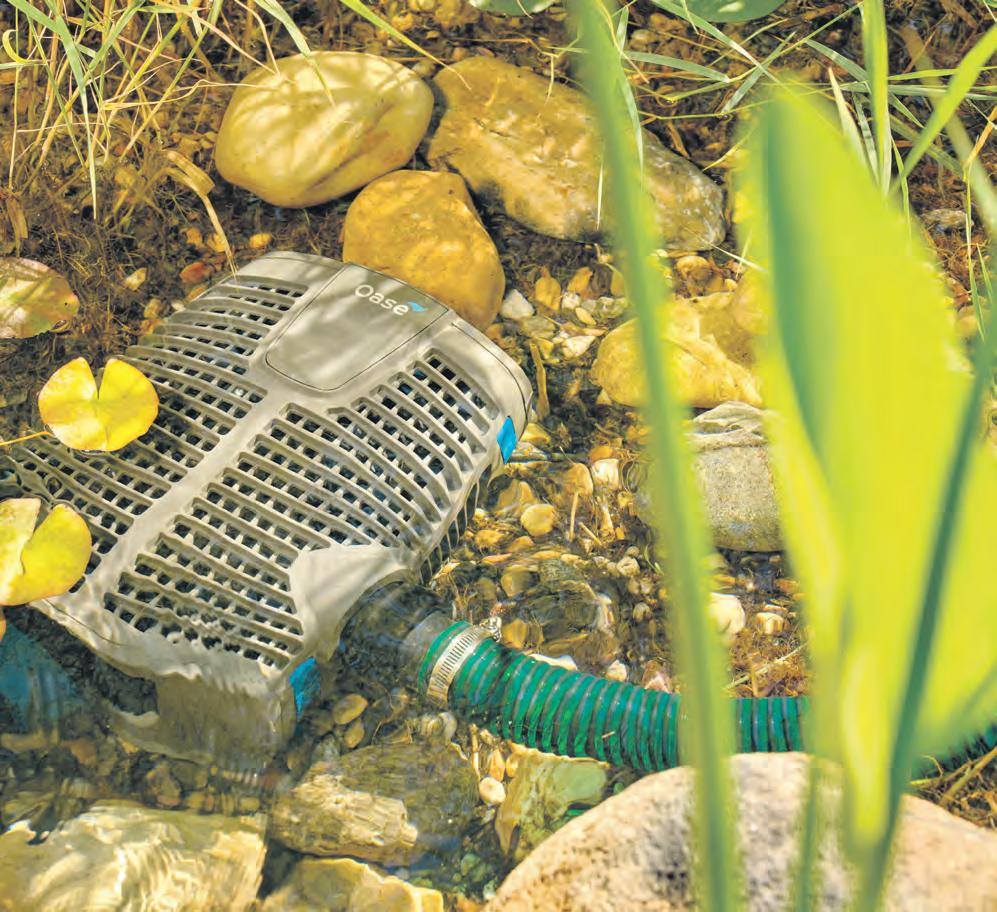

Maximise the efficiency of your pond
WITH THE NEW AQUAMAX ECO PREMIUM
OASE‘s impressive AquaMax Eco Premium has been updated with the latest technology to help you create a pond that‘s even more efficient.
This new version has the same great features as the previous model. Seasonal Function Control can automatically reduce the pump‘s output when the temperature drops. And Frost Protection keeps the pump running safely through the winter. It also still has a 5 (3+2) year guarantee.
There are also some impressive new features. Core 6 Technology is at the heart of the pump motor. OASE
is introducing this game-changing technology into the pond world; the pump is even more efficient than its predecessors. This means your energy costs are reduced by up to 24% compared with the previous models. Not only will your pond be kept crystal clear, but your wallet will be happy.
Speak to your local retailer about the new OASE AquaMax Eco Premium today.

Discover more at www.oase.com
welshslatewaterfeatures.co.uk
Stone
www.countrygardener.co.uk 29
JOBS IN THE May garden
May is with us and it brings many delights to our gardens. But don’t allow your excitement about the growing season ahead to fool you into assuming it’s summer already: this is the month when holding back can pay off in the long run. It’s still too cold for many tender plants to go outside fulltime.
And think about letting go of your mower: leaving lawns to go wild allows all kinds of delights to flower, much to the joy of the bees.
Plan a ‘no mow’ May
1Here’s a job to avoid this month: lock up your lawnmowers for No Mow May. This campaign by charity Plantlife encourages individuals and local councils to let grass in parks and on verges go wild for a few weeks, allowing dandelions, daisies, clover and other flowers to come into bloom and provide valuable pollen and nectar for bees and other pollinators.

3
Leave spring bulbs alone
It’s tempting to cut back and tidy daffodil and tulip leaves once they have bloomed, but it’s best to avert your gaze and live with them for a bit. Once your spring bulbs have finished flowering, leave them to die and break down naturally rather than cutting down the foliage.
If you have any spent flowers, deadhead to prevent plants from wasting energy creating seed heads. Add a homemade, liquid fertiliser around the clumps to help encourage strong growth for next spring. You can make your own liquid fertiliser from your compost heap – known as compost tea – or comfrey tea.
5
Take comfort in comfrey
Comfrey is a wonder plant – its tap root draws up nutrients from deep in the soil, and the leaves store nitrogen, phosphorus and potassium, making them perfect for use as fertiliser. You can harvest this foliage to make a liquid plant feed, add as a surface mulch or add to planting holes.
May is an important month for birds

2
Thinning out – it’s a ‘must do ‘job
Thinning out young plants is a necessary evil when it comes to both vegetable crops and annual flowers. If you leave seedlings bunched together, they outcompete each other and the result is stunted growth. For vegetables such as carrots and beetroot, you can eat the pickings; for annual flowers such as lovein-a-mist, pot marigolds and cornflowers, carefully dig up the excess seedlings with their roots intact and you should be able to transplant them into any bare patches.


4
Do the ‘Chelsea chop’
Cutting the stems of flowering herbaceous perennials such as sedums and asters will keep plants smaller and encourage more flowers. This should not be done on flowers which flower only once, or flowers which are intended to be tall and striking. This is a way of staggering the blooming of plants that flower in bursts over the summer such as rudbeckias, catmint (Nepeta), echinaceas and heleniums. You can either cut every plant back by a third, or restrict your trimming to some clumps and leave others: either way, it should create bushier plants that flower over a longer period.
8 6
Many gardens will play host to nesting birds so be careful not to disturb them particularly if you have dense hedges or trees. Don’t trim any hedge that has birds nesting in it – wait till the fledglings have flown the nest until you begin pruning. You can put up special nest boxes for swifts and house martins but swallows will nest on any suitable ledge or shelf so watch out for them in sheds and other outbuildings.

It is important to feed birds during the breeding season as parents and baby birds alike will need plenty of energy.
Don’t put out whole peanuts or other large chunks of food as there is a risk that the pieces could be fed by adults to their fledglings which could result in choking. Put out wild bird seed mixes or black sunflower seeds and kitchen scraps such as mild grated cheese, soaked sultanas, raisins and currants, oatmeal, and apples, pears and other soft fruit.
Put out a variety of bird feeders to attract different species. Hanging feeders will attract finches, tits and sparrows; bird tables will attract robins, doves, pigeons and bramblings, while food scattered on the ground or in ground feeders will attract blackbirds, thrushes, dunnocks and wrens.
Keep your bird bath topped up to provide a source of drinking water for birds. Be aware of hygiene and make sure you change the water regularly and scrub out the bath with a mild detergent to help prevent the spread of disease.
7
Feed your flowers and plants

Plant leeks
Leeks that were sown last month can be planted outdoors. Allow around 30cm between rows to make weeding easier, and space plants at 15cm-intervals for full-sized leeks. If you’re short of space, plant closer together and harvest alternate plants as baby leeks, leaving the rest to grow on to maturity.

Feeding now will pay dividends later, but you must use a slow-release fertiliser containing potash, to encourage more flowers. A general fertiliser can also be applied to roses, herbaceous plants and fruit. Avoid adding nitrogen-rich plant food: it produces too much leaf.
Vegetables will also respond to enriched soil. The easiest soil enhancer is well-rotted garden compost, so it’s worth making your own if you’re able to. You can also use wellrotted manure, although spreading it in early spring can be backbreaking. However, you can also buy bagged manure from garden centres. The best way to incorporate organic matter into a vegetable bed is to put some at the base of the planting hole.
Squashes and courgettes benefit hugely from sitting above organic material because it aerates and warms the soil.
For brassicas sprinkle on a nitrogen-rich feed, such as chicken pellets or powdered chicken manure, straight after planting. Root crops prefer lighter soil and are generally best grown in soil that hasn’t been enriched.
JOBS FOR THE MONTH
Country Gardener 30
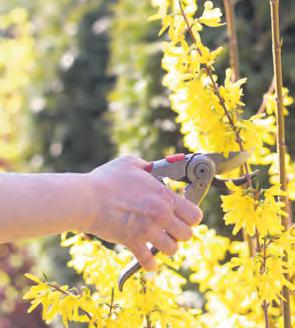
Prune forsythia
Prune forsythia after flowering. If you don’t do this every year, they quickly get unmanageable and flower less well. Using sharp loppers and secateurs cut a quarter of the old growth to the base. Also remove diseased, dead, dying and wispy stems cutting them to the ground. Finally prune stems that have just flowered to two buds above the previous year’s growth.
Stay on weather watch
At some point in May there is a tipping point: the risk of frost passes, and all the tender plants you’ve been tripping over indoors can be planted outside. So, keep an eye on the weather forecast and look for a rise in night-time temperatures – tomatoes, for instance, need a minimum of 10°C night and day before they can go out into a bed or container. May is the month to remove fleece covers from your veg, but have some at hand to cover newly planted or tender plants if frost is forecast. Hanging baskets, patio pots and tender border plants can also be moved outdoors once the danger for frost has passed. The later into May, the less likely it’ll occur, but a late frost could strike and blacken foliage and flowers. Harden off summer bedding and other tender plants in preparation for their transfer outside; this means putting them outside somewhere sheltered on warm days to gradually adjust to the conditions. Remember to bring them in before the temperature drops at night.
Flower seeds to sow in May
There’s no shortage of seeds to sow in the May garden, with many now being able to be sown straight into the soil outside.
Sunflowers, cornflowers, zinnias, nasturtiums, nigella, poppies and wildflower mixes can all be sown directly into beds, borders or outdoor containers.
In trays and pots you can start growing biennials and perennials, such as foxgloves, wallflowers, delphiniums, lupins and primroses in the greenhouse or on the windowsill to flower next year and years to come.


May is the perfect time for roses
Bare root rose planting season ended in April, so May is the ideal time to buy roses in pots from garden centres or specialist nurseries and plant them out for a dazzling display this summer.
There are so many delightful roses to choose from for different situations – from climbers to miniatures for pots on the patio. Decide where you’d like to add roses, whether you just want to cover a wall or arch, mix in with herbaceous plants or start a dedicated rose garden, Consider your colour scheme, the combination of scents and if you’d like a blaze of flowers in one blooming or repeat-flowering options.
There are two ways to buy roses: as container-grown plants, or as bare root plants. Bare root plants are usually purchased online or via mail-order and come in a semidormant or dormant state with no soil on the roots. They are the preferred choice for many gardeners bare-root roses are generally the best quality and have a wider spread of roots than container plants.
If planting multiple roses, bare root plants are more economical and there’s also a greater variety.
PLUS...
• Water anything newly planted. Any veg or flowers planted this spring will need regular watering while they settle in and put down roots into the soil, especially during dry weather. This also applies to any new turf you may have laid.
• It’s best to wait until May before sowing French or runner beans, so they’re ready for planting at the end of the month. Plants sown too early will turn yellow if planted out too early and will struggle.
Finish planting maincrop varieties, such as ‘King Edward’, by early May for crops in late summer/early autumn. Plant the tubers 40cm apart in rows that are 60-75cm apart. You can encourage your tulips to flower again next year by feeding them with tomato feed and removing any flowers that have faded. Bulbs in pots are best removed from the pots after they have finished, and then replanted deeply (around 15cm deep) in the border.
Country Gardener CROSSWORD
WIN £100 IN RHS GIFT TOKENS
Our popular gardening themed crossword is compiled by Saranda which over the past year has become enormously popular with readers. The winning entry to be drawn by us will receive £100 of RHS gift tokens. Completed entries should be sent to Mount House, Halse, Taunton, Somerset TA4 3AD. Closing date is Friday 17th May.
ACROSS
1. Common name of carpenter’s herb (4-4)
5. Houseplant also called hen and chickens (6, 5)
12. Dressed in fancy or formal clothing (6, 2)
13. Genus to which the marmalade bush belongs (12)
15. Common plant sometimes called holy rope (4, 8)
16. Someone who has had their marriage dissolved (8)
18. Roman goddess of fruit trees and orchards (6)
19. A greyish-yellow or parchment colour (10)
22. Genus of plants that include silk tassel (6)
23. Monetary unit of Egypt (8)
24. Garden vegetable with thick leaves and a round root (4)
28. Common name of Herminium monorchis (4, 6)
29. Biological, thick-walled cells (10)
31. An African tree, Vitellaria paradoxa (4)
32. Common name of Vernicia fordii (4, 4)
33. Compound first discovered in the pigments of butterfly wings (6)
36. George Orwell kept this flower flying? (10)
37. A tall and prickly Eurasian plant with shiny flower heads (6)
40. Godfather actor born 1940 (2, 6)
41. Common name of Equisetum hyemale (8, 4)
42. Common name of herb Aethusa cynapium (5, 7)
44. A chamber in a plant in which insects live (8)
45. The plant lore of indigenous cultures (11)
46. King of Ithaca and son of Laertes (8)
DOWN
1. A Russian cabbage soup (6)
2. A Fabaceae plant and French word for vegetable (6)
3. Logwood is a thorny tree of this genus (12)
4. Common name of plant in Heuchera genus (8)
6. Genus of plants including cinquefoil and silverweed (10)
7. Colour often derived from plants (3)
8. A severe febrile illness caused by rodent bacteria (3, 4, 5)
9. Flexibly or nimbly (8)
10. Legal term, literally ‘I do not wish to contend’ (4, 10)
11. Butcher’s broom or ____ holly (4)
14. Compound leaf that is divided up into many small leaflets (13)
17. Aquatic vegetable enjoyed by the Chinese (5, 8)
20. Bantu drums (6)
21. Christmas vegetable? (8, 6)
25. A herbal tea or infusion (6)
26. Barometz, a highly unusual vegetable? (8, 4)
27. Stipa pennata (7, 5)
30. A way to cleanse a carpet? (5, 5)
34. Concerning the territorial jurisdiction of a bishop (8)
35. Common name of flowers of Tagetes genus (8)
38. Alternative name for bluebonnet, the state flower of Texas (6)
39. Genus to which the common thyme belongs (6)
40. Four-leaf clover is displayed by this Romeo? (4)
43. Drinker spotted in Minnesota (3)
9
13
10
11 12
CROSSWORD 1 2 3 4 5 6 7 8 9 10 11 12 13 14 15 16 17 18 19 20 21 22 23 24 25 26 27 28 29 30 31 32 33 34 35 36 37 38 39 40 41 42 43 44 45 46 S O C A G E O C A S E Y R E F I T C E H A U F U L A A B L U S H P E D U N C U L A T E O A K M A N O R C A I A W E M A N G E L W U R Z E L O N S C R E E N O T R N Y A D E R O N A R C I S S I A L P I N E G A R D E N Y O A U G O G R E E T S C U P P E R N O N G S A L A R A A E R E O I A U U V E R B A S C U M B R A S S I C A S O I E L I A L I E T C O S T O F N O B L E B I R T H A T F U A S R G T L R D O O M A N D G L O O M M U C I L A G E O L R B L S A N M I P H O R M I U M P U T T I N G G R E E N E C T R L T R A D L E A S H R O P S H I R E L A D N U T L E T R U T M L C A T S P A W N B R Y O N Y E K W E L E Answers from previous issue, April 2024: 31
So how can you HELP BEES?

World Bee Day is now observed on 20th May each year and reminds everyone and especially gardeners of the essential role bees and other pollinators play in keeping the planet healthy.
Most gardeners now have a detailed awareness about the problem facing the decline in bees in our gardens and thankfully so many are doing something about it with improved planting regimes, growing more wildflowers plants and shrubs which all aid the pollinating process.
However, UK bees are still in severe decline with habitat loss, pollution and climate change pushing them towards the edge. These tiny insects are an integral part of our ecosystem, but with their numbers plummeting, our natural world and even our own lives could be in serious trouble.
Without bees (and thousands of other insect species that call the UK home), it wouldn’t be long before our ecosystem collapsed. Bees pollinate our wild trees and wild flowers, which then support other insects, which then support birds, bats, mammals and everything up the food chain with food and shelter.
There are more than 250 species of bee native to the UK. 24 of these are bumblebees, of the genus Bombus, while the rest are all solitary bees, like mason bees and mining bees. Bumblebees nest in colonies, while solitary bees live and nest alone.
One species of honey bee – the European honey bee – lives in the UK. These are farmed bees that have been introduced by
beekeepers, rather than being native to our shores. Sadly it’s now incredibly rare to find a truly wild honey bee colony. So, how you can help bees?
Stop using pesticides
You can make a big difference to bees and other wildlife by stopping using pesticides in your garden. Some pests provide food for crucial pollinators as well as birds and other animals, so leaving them to be controlled naturally is the best choice if you want to help save bees.
Provide shelter
Like most invertebrates, bees need shelter to nest and hibernate in. You can buy a ready-made bee hotel or create your own –just hang it up in a sunny, sheltered spot and watch bees filling the tubes during the spring and summer months.
Remember that it’s really important to keep your bee hotel clean to prevent the build-up of pests and mould.
Grow bee-friendly flowers
Bees favour a wide range of flowering plants, including foxglove bird’s-foot trefoil and red clover. You don’t need to be greenfingered, just scatter them and watch them grow!
Grow flowers from seed to attract bees and butterflies with Premier Seeds Direct
There are plenty of flowers that will not only look colourful over the summer but will also attract the Bees and Butterflies into your garden.
If you are looking for inspiration, try the Butterfly and Bee Flower mix from Premier Seeds Direct, with 17 varieties of annuals and perennials it will deliver a fantastic display and maximise nectar all summer long.
For something more specific Cosmos is a great option and grows easily from seed, its long vase life makes it very popular for cutting and the open flowers give easy access to nectar making it one of the best flowers for bees. With plenty of varieties to choose you’re sure to find something you like or try the ever popular Sensation Mix.
www.premierseedsdirect.com
ROSYBEE AIMS TO MAKE GARDENS
MORE WILDLIFE
FRIENDLY
Rosybee is an independent plant nursery specialising in plants for pollinators, aiming to make gardens more wildlife-friendly. Their range is based on many years of research to ensure they provide plants that maximise the pollinator food supply. The research and plenty more tips on wildlife gardening can be found on their website. Great value plants in trays of six. All plants are grown peat-free and pesticide-free and in recycled plastic trays.
www.rosybee.com


Watersfield, Bletchenden Road, Headcorn, Kent. TN27 9JB | 07779728378 | www.beanplace.co.uk | Follow us on Specialist growers of hardy perennials, ornamental grasses and garden ferns. All carefully packaged and delivered to your door Shop online www.beanplace.co.uk Quote CG10 for 10% off your first order Grown in the garden of England Buy direct from the grower BEES & WILDLIFE
Country Gardener 32
HABITAT AID SUPPORTS PLANTS AND SEEDS WITH HIGH QUALITY ADVICE
Habitat Aid is a small award-winning business based in South Somerset. It has been selling plants and seed since 2008, sourced from a community of small growers and harvesters around the country.
The company specialises in native plants, but also has a big selection of heritage fruit trees. It offers practical tailored advice on improving biodiversity in gardens and estates too.
Habitat Aid is about supporting and promoting its suppliers and giving its customers access to good advice and appropriate and ethically produced plants and seeds.
It also has a structured giving programme too, donating two percent of sales to small UK conservation NGOs.
www.habitataid.co.uk
www.britishwildflowermeadowseeds.co.uk


Local Meadow Seed available to buy online

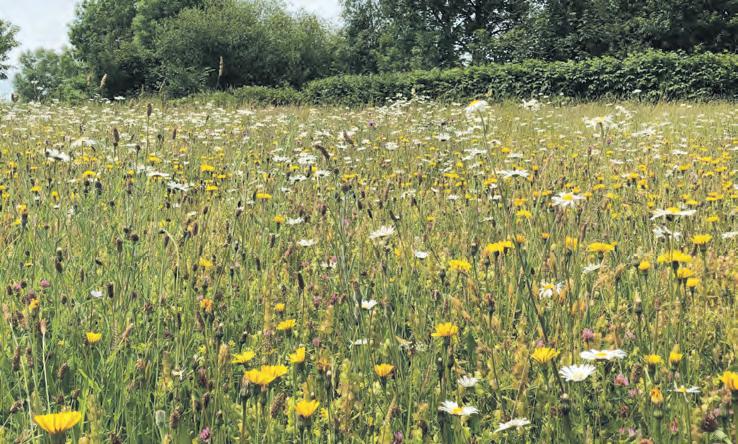

• Wildflower Seed


• Plug plants


• Pond plants


• Hedge whips


• Fruit trees


Improve your biodiversity Consultancy Packages



www.HabitatAid.co.uk



• Woodland trees





BEES & WILDLIFE
33
www.countrygardener.co.uk
Bee aware
Rosi Rollings owns a specialist plant nursery that sells plants for bees online (www.rosybee.com). She has also spent the last 12 years studying which garden plants attract the most bees and explains how our gardens can often have as many as 20 different types of bees working away.
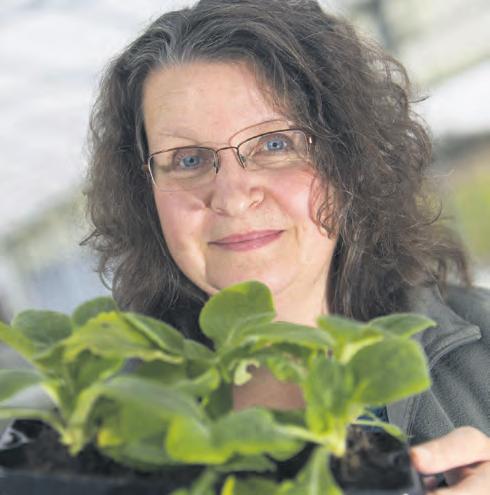
Which bees are in your garden?
When I talk to people about bees in their gardens I find that everyone is familiar with bumblebees. They are also aware of honeybees but might not be able to identify them in an insect line-up. Increasingly, gardeners are also now becoming familiar with some of our ‘mason’ bee species and buying bee ‘hotels’ for them.
However, there are a lot more species of bee than that; in the UK we have around 250 different species of bee. In even the smallest gardens you will find at least 20 if you have flowers and know what to look for. Bees foraging on flowers will not sting unless attacked (swatted?) or stood on and so are safe to observe quite close up.
Common that are easy to identify
If you want to find out which bees are in your garden then bumblebees are still a great place to start. We have 25 different bumblebees but seven of them are very common and found in all areas of England and Wales. They are easy to spot because they are big and noisy with their low-pitched buzzing. In springtime, gardeners comment on having seen some massive bumblebees. These are the queen bumbles which are the only
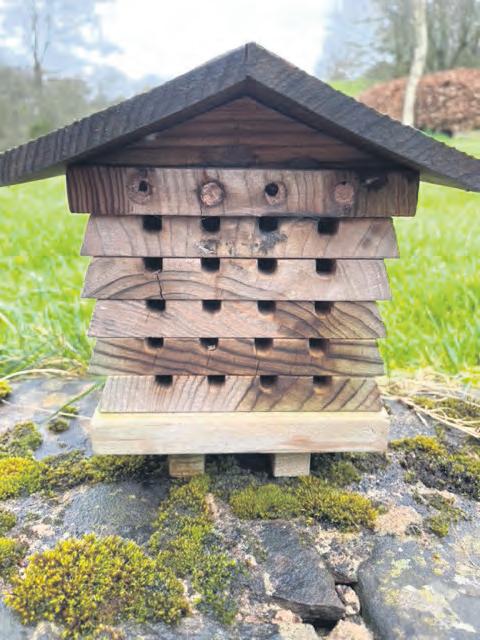

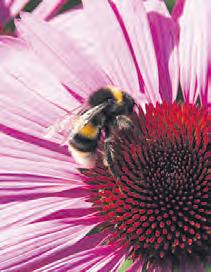

members of their colony to survive the winter, typically hibernating in soil and also compost heaps or sheltered plant pots. They are large, between 12 and 17mm wingspan.
When they emerge in spring they can be seen flying low over the ground and exploring various nooks and crannies looking for potential nest sights. Once they have found one, they will disappear inside to make their nest and start the new colony.
About a month later the much smaller workers will begin to be seen in greater numbers.
Our most common bumblebees are the ‘early’, the ‘common carder’ and the ‘buff-tailed’ bumblebees each of which is relatively distinct (see pictures) so you should be able to identify them. Bumblebees have relatively long tongues so can reach the nectar in a wide range of flower shapes. They are also the only type of bee that can pollinate tomatoes, potatoes, strawberries and many other valuable foods for us. Great to attract to a vegetable garden!
Honeybees
There is only one species of honeybee and although all bees collect pollen and nectar, to feed themselves and their young, only honeybees make honey. This is because
they are also the only bees where a large portion of the colony lives through the winter and so they need the honey to feed themselves during that time.
Very few honeybees live in wild colonies and unlike all the other bee species the majority are essentially domestic animals, kept in hives. Honeybees are common in most gardens but the number you might see will depend on where your hives are located. Honeybees have relatively short tongues which is why you might have heard it said that bees prefer open, simple flowers.
Solitary bees
All the rest of the 225-odd UK bee species are categorised as ‘solitary’ bees. This simply means that they do not live in colonies and that after mating, the female raises her offspring by herself. This will involve forming a shelter (usually mud-based cells in either wood cavities or soil), laying her eggs, providing them with a plug of pollen to eat when they hatch and then repeating this process for the six weeks of her short life. She will die before meeting their offspring.
There are 24 different families of solitary bees and many of them are very small and difficult to identify while flying around. Most people will not even realise they are bees as they can easily be mistaken for a fly or hoverfly. Some are only the size of a dark grain of rice. But if you start to look closely, you will see some of the tell-tale signs that let you know it’s a bee: when at rest it has wings that are folded back along its body, not held out diagonally as hoverflies do.
They have two sets of wings and usually have short antennae.
After that, it gets a bit tricky but there are some bees that you can learn to spot quite easily and once you get your ’eye in’ it gets easier.
Some solitary bees to look out for in your garden
The ‘mason’ bees are lovely small fluffy bees that will be very happy to come and inhabit a bee ‘hotel’ if you put one up in a sunny south-facing spot. It’s best to choose one with holes that are at least 20cm long. Amazingly, ‘mason’ bees can choose the sex of the eggs they are laying and always lay male eggs near the entrance. If the tubes are too short they lay more male than female eggs and that is not good for future generations. The picture shows my favourite type of bee hotel as it allows you to clean it out occasionally too.
Some of the noisiest bees are the ‘hairy-footed flower’ bees, so named because the males have long hairs on
Bee hotel
Carder bumblebee
Early bumblebee
Country Gardener 34
Buff-tailed bumblebee
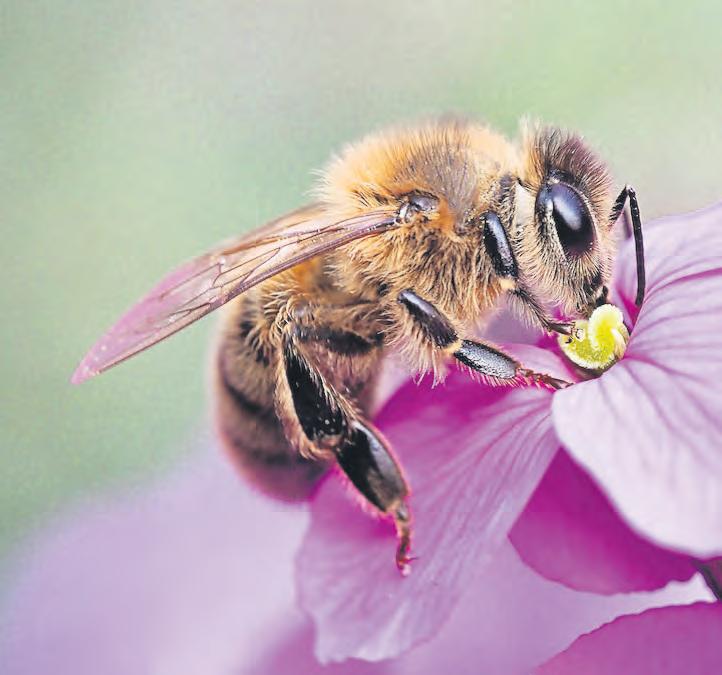



their legs. In springtime, these bees can often be heard before they are seen as they have a distinctly highpitched insistent buzz. They also have an unusual flight style for a bee; most bees keep in continuous movement until they land on a flower but these guys zip speedily between flowers and then hover like a small hummingbird in front of their target nectar source. They are strongly attracted to pulmonarias, comfrey and other spring-flowering plants.
One to look out for in mid-summer is the very territorial ‘wool carder’ bee. These are easiest to spot if you grow lambs ears (Stachys byzantina).
Close up, the ‘wool carders’ look almost like a fat wasp, being black, and squat with yellow spots down each side.
Best plants for solitary bees
The female bees like to collect the soft hairs from the plants’ leaves to line their egg cells. This means that the males quite often patrol a patch of ‘lambs ears’ waiting for the ladies to come by.
Once they have found a territory they can be seen actively protecting the space, attacking any much larger bumblebees that might stray into it.
There are a couple of examples of the tiniest bees that can be found by close examination of their favourite flowers. Campanulas of all types attract the tiny ‘small scissor’ bee which has only a 3mm wingspan but are black so the contrast is enough to make them visible.
You probably already have bumblebees and honeybees in your garden but if you want to attract a wider variety
I recommend adding the following to your borders:
Geranium rozanne and campanulas - Attract lots of different bees including some tiny ones.
Anthemis tinctoria - Yellow daisy that attracts a variety of solitary bees.
Centaurea montana - Blue perennial cornflower that is excellent for mason bees in spring.
Eryngium planum (or other eryngiums) - Which is a good all-rounder.
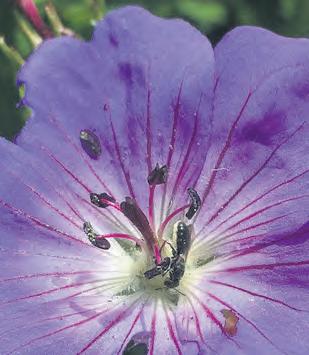

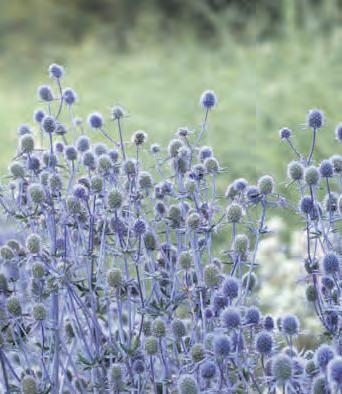
Diary events from clubs and organisations in SOMERSET

Garden clubs and associations are starting to fill up their events calendar for the new season. If you would like to share club events then take advantage of our traditional free service which lists events, meetings and outings. Send your information to timeoff@countrygardener.co.uk
April
23RD
Barrington Gardening Society
ANNE SWITHINBANKGUEST SPEAKER
Details on 01460 54691
Isle of Wedmore Gardening Club ‘NEW TRICKS FOR OLD GARDENERS’KATHERINE CROUCH www.wedmoregc.co.uk
25TH
Taunton Flower Club ‘APRIL SHOWERS’ANDREW LLOYD
May
8TH
Nailsea & District Horticultural Society ‘HISTORY AND RESTORATION OF PAINSWICK ROCOCO
GARDEN’ - DOMINIC HAMILTON
Details on 01275 855342
Kilmersdon Gardeners ‘GARDENING FOR MOTHS’ - COLIN HIGGINS kilmersdongardeners.org
9TH
Chew Valley Gardening Society
‘POND GARDENS’
Details on 01275 333456
East Coker Gardening Club
‘SLIGHTLY NAUGHTY PLANTS’ - STEVE FROM THE GOLD CLUB
11TH
Tickenham Village Hall TICKENHAM FLOWER SHOW 2pm
14TH
Frome Selwood Horticultural Society ‘FUCHSIAS MY WAY’DEREK DEXTER
Details on 0777 6208531
Sedgemoor Gardens Club
BRIMSMORE DISCOUNT VISIT - GOLD CLUB sedgemoorgardensclub.co.uk
Details on 01458 259025
17TH
Carhampton Gardening Club ‘GARDENING WITH PEAT FREE COMPOST’VICTORIA WRIGHT
Details on 01643 821085
18TH
Kilmersdon Gardeners ‘PLANT SALE - VILLAGE HALL
10.30am - 12.30pm kilmersdongardeners.org
21ST
Bleadon Horticultural Society
‘THE ANSWER LIES IN THE SOIL’ - DAVID USHER
The Gardening in Retirement Club, Downend, Bristol ‘CONTAINERS’ - KAREN BEASLEY
Details on 01179 656844
23RD
Taunton Flower Club ‘POT LUCK’ - MARGARET HEAL
25TH
Frome Selwood Horticultural Society ANNUAL PLANT SALE Selwood Academy
Details on 0777 6208531
28TH
Chilcompton Gardening Club ‘GARDENING FOR MOTHS’ - COLIN HIGGINS
Details on 07791 537429
Isle of Wedmore Gardening Club ‘PLANT NAMES (AMUSING & EDUCATIONAL’ - BRIAN JAQUES www.wedmoregc.co.uk
www.countrygardener.co.uk 35
HONEYBEES
BEES
SOLITARY
Hairy footed bee
Wool carder bee
Geranium rozanne scissor
Anthemis tinctoria Eryngium planum
TIME OFF
ACCOMMODATION
Churchwood Valley
Secluded cosy cabins & lodges in wooded valley running down to Wembury Bay & SW Coastal Path

Forest School. Tel: 01752 862382 www.churchwoodvalley.com

Carmarthen Bay South Wales
Seafront chalet situated on estuary. Sleeps up to 6. Seaview. Well Behaved Dogs Welcome Free of Charge. Free WIFI. Open from 1st March - 31st Dec. For Brochure Tel: 01269 862191
NORTH DEVON. THE POTTING SHED. Sleeps 2. Set in a beautiful walled garden. Close to RHS Rosemoor. Call Mary on 07811 425278
GLORIOUS NORTH DEVON. Only 9 cosy caravans on peaceful farm. Wonderful walks in woods & meadows. Easy reach sea, moors & lovely days out. £125-395pw. Discount couples. Nice pets welcome. 01769 540366 www.snapdown.co.uk
BOSWORLAS, ST JUST. Cosy Cottage sleeps 2-4. Please email info@bosworlas.co.uk for availability
SOUTH DEVON LODGE on peaceful farm. Sleeps 4. Central for beaches, Salcombe and Dartmouth. Phone for details 01548 853669.
ACCOMMODATION HOLIDAY COTTAGES
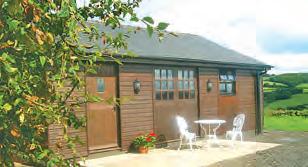
Peace, Privacy, and Stunning Views!
4* Delightful cosy cabin for 2, nestling between Wye and Usk Valleys. Shirenewton village & pubs close by. Wonderful walks, splendid castles, bustling market towns. Perfect for all seasons!
Tel: 01291 641826
Email: lynne@bryncosyn.co.uk www.bryncosyn.co.uk


Gloucestershire Quality Bungalow B&B


HOLIDAY COTTAGE SIDMOUTH, DEVON
A quiet holiday bungalow near Sidmouth, overlooking the Donkey Sanctuary. Ideal for walkers and nature lovers. Sleeps 4. Bookings from April to the end of October.
jandtmercer@gmail.com www.sandwaysholidaycottage.co.uk
07842 514296 SANDWAYS
WYE VALLEY/FOREST OF DEAN.
Fully equipped single-storey cottage with two en-suite bedrooms. Wi-fi.Recently awarded Visit England 4-star GOLD. Rural retreat, shops/pubs one mile. Enquiries welcome. AS SEEN ON ESCAPE TO THE COUNTRY! Tel: 01594 833259 www.cowshedcottage.co.uk
ACCOMMODATION WITH BEAUTIFUL GARDENS

Near Stratford-upon-Avon
Lovely self-catering cottage in peaceful location: large garden. Sleeps 2. Perfect for famous gardens, NT properties & Cotswolds. Tel: 01789 740360 www.romanacres.com

Tel: 01792 391212 www.penricecastle.co.uk
NORTH DEVON NEAR CLOVELLY. 3 delightful cottages situated in 12 acres of idyllic countryside. Sleeps 2-4. 1 Wheelchair friendly. Brochure: 01237 431324 www.foxwoodlodge.co.uk foxwoodlodge@outlook.com
Ensuites, rural, large garden, paddocks, sheep and fruit. Ideal Cotswolds, Malvern’s, Forest of Dean, cycle storage, ample parking, Wi-Fi £42 p.p.p.n. Tel: 01452 840224 sheila.barnfield1960@gmail.com
CARDS

A range of over 200 greetings cards and prints from the flower paintings of ANNE COTTERILL
We sell to both individuals and trade. No order too small. Contact us for your free catalogue.
Mill House Fine Art Publishing, Bellflower Gallery, Market Place, Colyton, Devon EX24 6JS Tel. 01297 553100 info@millhousefineart.com www.millhousefineart.com

THE GARDENER’S
BLACKSMITH
jonne@jonne.co.uk 07770 720 373

www.thegardenersblacksmith.co.uk

Yenstone Walling Dry Stone Walling and Landscaping
Patrick Houchen - DSWA member Tel: 01963 371123 www.yenstonewalling.co.uk


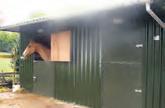
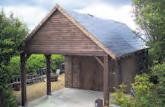





BED & BREAKFAST
& GIFTS GARDEN PLANTS/ACCESSORIES GARDEN SERVICES POLYTUNNELS SEED SUPPLIERS SPECIALIST GARDEN PRODUCTS SPECIALIST NURSERIES TERRACOTTA POTS
CLASSIFIED
Plymouth, Dartmoor & lovely South Devon Villages & Towns in easy reach. Pets Welcome.
Want this space? ADVERTISE HERE FROM JUST £2 PER WORD Email: classified@countrygardener.co.uk for more details
Artist blacksmith based near Axminster designing and manufacturing garden plant supports, structures, garden art and fine art bronzes. Commissions welcomed.
POLYTUNNELS FROM £499 AVAILABLE TO VIEW BY APPOINTMENT 01363 84948 info@ferrymanpolytunnels.co.uk www.ferrymanpolytunnels.co.uk CustomTimberBuildings.co.uk Ex-display buildings for sale | Anything to order 01935 891195 Stables Garages Garden Offices Log cabins Request a copy of our NEW 2024 catalogues 01376 570 000 or at www.kingsseeds.com
FORTON NURSERY Top Quality Perennials, Shrubs & Trees T: 01460 239569 E: fortonnursery@btconnect.com W: www.fortonnursery.co.uk Forton village, near Chard TA20 4HD Closed Tuesdays and Wednesdays CERTIFIED ORGANIC VEGETABLE PLANTS Growers Organics, Kitley Farm, Yealmpton, Devon PL8 2LT www.growersorganics.com Tel: 01752 881180 Est. 2003 Stockists of frostproof pots and garden ornaments from Greece and around the world as well as a host of other gifts and bits and pieces Open every day Eastoke Corner, Hayling Island, Hants P011 9LU 02392 637590 The Terracotta Pot and Gift Shop Country Gardener 36
Penrice Castle Gower 17 holiday cottages on an 18th century Estate on the Gower Peninsula with beautiful Grade I listed historic park and gardens.
FRI 3 & SAT 4 MAY 2024 10AM
Powderham Castle, Devon
TOBYBUCKLAND RACHELDE


THAME SUEKENT

Join BBC TV gardeners Toby Buckland, Sue Kent and Rachel de Thame for our 10th anniversary celebration
Two days of plant shopping, delicious food, music, free garden talks and workshops
Plus...
• Plants galore from the best plant nurseries in the West
• 200 stalls and exhibitors, including top quality arts and crafts
• Mouth watering locally made street food
• Drinks talks and wine tasting
• Food and drink Devon special with Mark Diacono and Susy Atkins
• Join us for Tea in the Castle
- a special afternoon treat in Powderham Castle’s Music Room
SECURE YOUR DISCOUNTED TICKETS TODAY!

THE FIRST GARDEN FEST TO GO CARBON NEUTRAL!
We’re dog friendly
ROCKY MOUNTAIN NURSERY
MASBURY,NR.WELLS,SOMERSETBA53HA
TEL:01749841014FAX:01749841055
www.rockymountainnursery.co.uk
Wehaveagoodselectionofperennialsandshrubsthatarelooking good,withlotsofcolourtobrightenyourgardenorpatio. OurshopJamesStorenowhasalargerangeofHomeBrewproducts Seeourwebsiteformoredetails www.rockymountainnursery.co.uk
HOMEGROWNTREES(ROOTBALL&CONTAINERISED) SHRUBS,PERENNIALS,CLIMBERS&GRASSES

ALLYOURGARDENINGNEEDS –SETIN12WONDERFULACRES–
BROWNE’S GARDEN CENTRE
Come and relax in our coffee shop and then select from our large selection of container grown shrubs, perennials, roses, fruit & ornamental trees
Huge selection of terracotta & glazed pots
Fencing, paving & aggregates
Plus all your garden sundry requirements
OPEN: 9am-5pm Monday-Saturday Closed Sunday
Coffee shop open 10.30am-4pm Monday-Saturday Closed Sunday
GLASTONBURY ROAD, WELLS TEL: 01749 673050








Landscape design
Bespoke landscapes constructed
Fencing and paving
Grass cutting and strimming
Remote controlled bank and slope
grass cutting
Invasive weed control
Paddock and pasture weed control
Tree surgery
01278 653205
www.greenslades.biz
Main Road, Cannington, Bridgwater TA5
TOBY BUCKLAND SUEKENT S U SY ATKINS RACHELDE THAME JACQUIE FELIX-MITCHELL SOUTH DEVONCHILLIFARM P LANT GENERA T I O N FRESHFLOUR SOLLIEHUTSON OWMUCH MORE M E A D O W I N YM NEDRAGHUTCHHOUSE PLA N T S PIQ I GRAZERS F OOD DRIN K D NOVE BARNYBUTTERFIELDOFSANDFORDORCHARDSHAWKSMOORINVESTMENT BLACKDOGHONEY BEES WICKHAM S W I N E MARK DIACONO EN W W O O D TREES THORNTON’SGROWING AND LIVING JIMBUTTRESS
TO
5PM
www.tobygardenfest.co.uk
ONLINE TICKETS FROM £13.50 - AVAILABLE UNTIL MIDNIGHT ON 2ND MAY
37
2LD
E Ennjjooy y a m meeaal l o or r d drriinnk k i in n o ouur r C Cooffffeee e S Shhoop p a n nd d b brroowwsse e a r ro o u unnd d J Jaammees s S Stto o r ree. . L La a r rgge e s st t o occk k o of f H HOOMME E B BR R E EW W P R ROODDUUC C T TS S n noow w a v vaaiilla a b blle e + m ma a n ny y o otthheer r g grreeaat t b ba a r rgga a i inns s
Have they only just spotted these fabulous trees
Mark Hindlsey is at least glad the wonderful Giant Redwood trees have finally got some belated praise even if it is 170 years after they first arrived with us.
Stop the press! Hold the front page! The mass media has just spotted Sequoiadendron giganteum (Giant Redwood or Wellingtonia) trees growing in the UK. Suddenly they are all over everything - television news, online, in the papers, probably mentioned in dispatches.
So, well done guys and gals, they have only been here since 1853!
“Ah…. but they are tall now”.
There was a Wellingtonia at Fonthill Abbey, Wiltshire which was 106ft tall in 1906. The same tree was 165ft tall by 1957.
One grown from original seed at Stratfield Saye, the old Duke of Wellington’s seat, was 85ft in 1903, 90ft four years later and 118ft in 1968.
A specimen in Castlehead, Devon was 172ft in 1988.
In 1984 I climbed one in the grounds of Albury Park, Surrey which was 145ft, sadly, and rarely for the species, it blew down in 1987, but it did have its feet in the Tillingbourne, which restricted its root system on one side.
This fabulous tree has a controversial history. In 1852 there were two plant collecting missions on the west coast of America. One was conducted by Dr Albert Kellog, a physician and botanist, who founded the California Institute of Science, and the other by William Lobb, a commercial plant collector sponsored by the Veitch Nursery of Exeter, who was part way into a three-year collecting expedition to bring back to Britain plants from the New World.
Dr Kellog was the first botanist to find a Giant Redwood. He collected specimens for his herbarium and carried on with his collecting mission. Dr Kellog was primarily interested in new species of oak. However, when he eventually finished his expedition, he planned to name the tree Washingtonia in honour of America’s first president.
A few weeks later when William Lobb arrived at the grove of the Giant Redwoods, he immediately grasped the huge commercial potential of this giant tree. He also became aware of Kellog’s plans for how to name it. He therefore hastily collected specimens and seed, cut short his expedition, and set off back for London.
It was 1853 when William Lobb presented his new species of tree to John Lindley of the Horticultural Society, who was tasked with naming it. He decided such a magnificent tree should be named after England’s recently departed hero, the Duke of Wellington. So Wellingtonia gigantea it was.

When Dr Kellog finally returned to civilization and sought to name his new tree, to his absolute horror, he discovered that William Lobb had beaten him to it. There then followed the Mother and Father of a transatlantic row which continued to rage for years.
Only years later, when the chromosome counters decided the Wellingtonia was closely related to the Sequioa sempervirons (Coastal Redwood), and
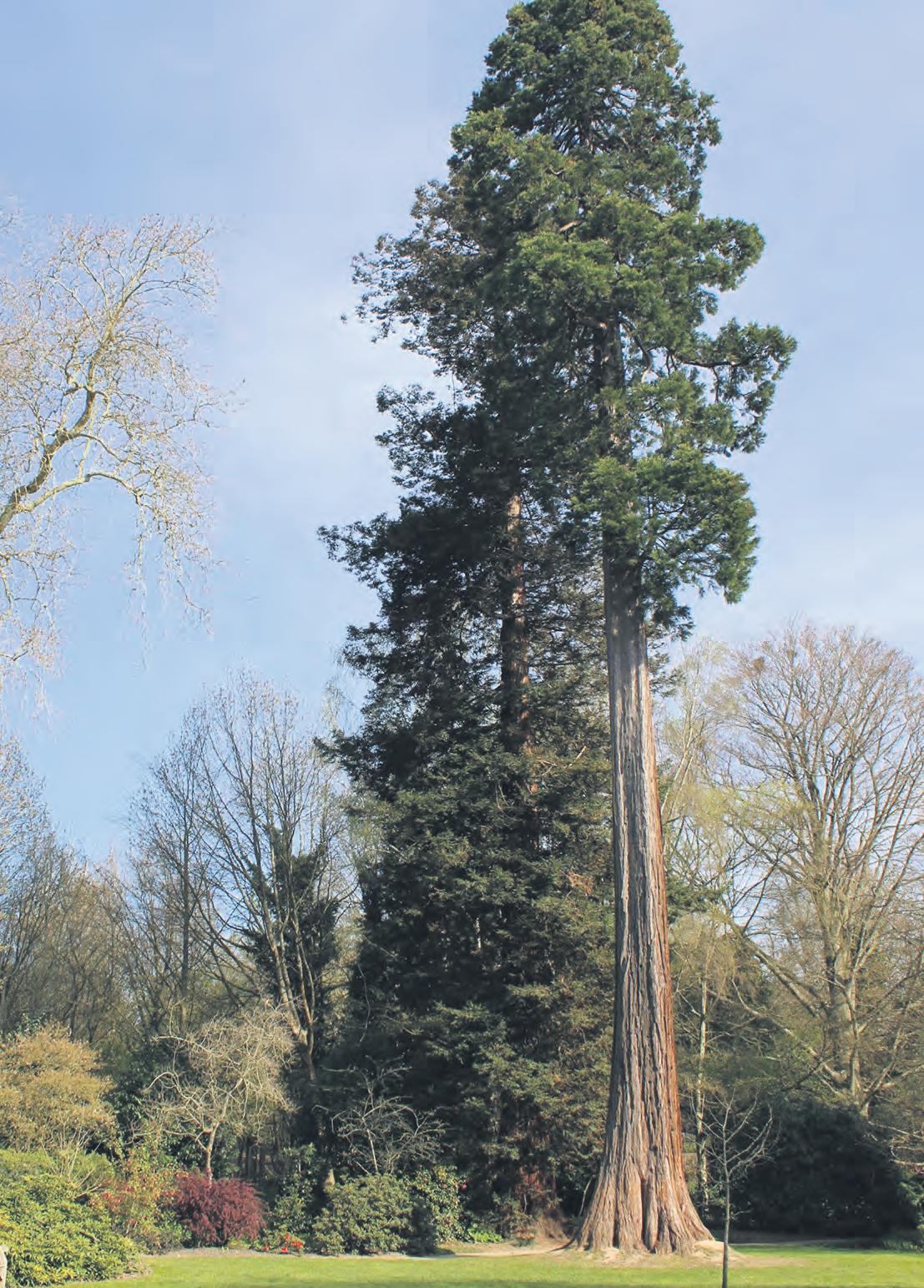
therefore changed its name to Sequoiadendron giganteum to reflect this, did the fuss die down a little. But not much, because for some reason or other, we have tended to continue to call the tree by what is its British common name which still is Wellingtonia!
So popular has the ‘Wellie’ become that there are now many more of them in Britain than there are in California, and it is more difficult to find a country estate which hasn’t got at least one than to find one which has!
How long they will live in this country and how big they will grow is unknown because original seedlings are still alive and still growing.
Fewer exotic trees have made a greater impact on the English countryside than the Wellingtonias” wrote Scott Leathart (Whence our Trees – great book!) in 1991.
But don’t put one in your garden.
You can see towering examples of S. giganteum at close range at:
• NT Killerton in Devon • NT Scotney Castle in Kent
• NT Stagshaw garden in Ambleside in the Lake District • NT Penrhyn Castle near Bangor
The Country Gardener magazines are distributed FREE at Nurseries, garden centres, National Trust Properties, open gardens, garden machinery specialists, country stores and farm shops in each county. All rights reserved. No part of this publication may be reproduced, stored or made available in any form, without the written permission of the copyright holder and Publisher, application for which should be made to the Publisher. Unsolicited material: do not send or submit your only version of manuscripts and/or photographs/transparencies to us as these cannot be returned to you. While every care is taken to ensure that material submitted is priced accurately and completely, we cannot be responsible or liable for any loss or damage suffered. Views and/or opinions expressed in this publication do not necessarily represent those of Country Gardener or the Publisher. Printed by Mortons Print Ltd, Morton Way, Boston Road Industrial Estate, Horncastle, LN9 6JR. Editorial Publisher & Editor: Alan Lewis alan@countrygardener.co.uk Tel: 01823 431767 Time Off Kate Lewis timeoff@countrygardener.co.uk Advertising Sales Ava Bench - Somerset & Hampshire ava@countrygardener.co.uk Tel: 01278 786139 Cath Pettyfer - Devon cath.pettyfer@countrygardener.co.uk Tel: 01837 82660 Corina Reay - Cotswolds & Dorset corina@countrygardener.co.uk Tel: 01823 410098 Classifieds classified@countrygardener.co.uk Accounts and subscriptions Heather Rose heather@countrygardener.co.uk Design & Production Aidan Gill aidan@countrygardener.co.uk
Stringer
Gemma
gemma@countrygardener.co.uk
Stockists distribution@countrygardener.co.uk
Distribution &
Magazines
TREE SPECIALIST
www.treeadvice.info The size of the tree is staggering
Mark Hinsley, of Mark Hinsley Arboricultural Consultants
Ltd,
offering tree consultancy services.
Country Gardener 38
The fabulous Sequoiadendron giganteum has a controversial history

Secure Self Storage



CHELSTON NURSERIES
QUALITY PLANTS SINCE 1951
For home-grown plants
Always something new and unusual Herbaceous perennials, shrubs and climbers Seasonal Bedding Tools, seeds and compost Glazed and frostproof terracotta pots National Garden Gift Vouchers On the A38 Wellington by-pass www.chelstonnurseries.co.uk Tel: 01823 662007

Visit our new cacti and succulent house. We also have a new range of restio and protea as well as great ranges of bamboos, tree ferns, ferns, cannas, gingers, bannas and shrubs, perennials, trees Open every day 10am-5pm
Lower Henlade, Taunton, TA3 5NB (5 mins from J25, follow A358 to Yeovil, then signs to the Mt Somerset Hotel) Tel: 01823 443701 www.deserttojungle.com

HPS Somerset Group
SUMMER PLANT FAIR
Saturday 15 June 2024
12 noon to 5pm at Batcombe House, Batcombe, Shepton Mallet, Somerset BA4 6HF
Many top nurseries and other stalls in attendance.
Refreshments available. Free Parking nearby.
Admission charge payable at the gate: £7.50 (proceeds to NGS) Visit www.somersethps.com for more details

SHEDS & FENCING
Summer Houses, Log Cabins, Decking, Home Offices, Workshops, Play Houses, Chicken Houses
Compound A, Dunball Wharf, Bristol Road, Bridgwater TA6 4BJ
Telephone 01278 686267
Open 6 days a week
www.promptcabins.com
Barn Close Nurseries
Taunton’s plant plug centre, Henlade

Call our Head Office 01460 243100
Lopen Business Park, Mill Lane, Lopen, Somerset, TA13 5JS
www.beehiveselfstorage.co.uk
Visit us at Lopen Business Park
Taunton | Lopen | Dorset 01460 241800

Flexible & affordable 24 hour digital CCTV Insurance options available Packing materials in stock Local in
Buy toys online or instore


www.beehivetoyfactory.co.uk
Tel. 01823 443507 Open 7 days a week 9am - 5.30pm On the main A358 Taunton to Ilminster road next to Henlade post office
• Geraniums £3.00 for ten
• Busy lizzes, petunias, lobelia, bedding begonias £11.00 per 100

• Baskets plants £7.00 for ten
• Refill baskets from £12.00
• Levington professional compost 75 litres £7.40 per bag, 5 bags £36.00
Why use mail order or garden centres when you can buy quality plants locally at lower prices?
A large variety of plugs available including ivy leaf geraniums, nemesia, diascia, visit our website at
www.barncloseplugcentre.co.uk



www.countrygardener.co.uk 47
Lopen
Hardy Exotic Plant Centre



ADD COLOUR TO YOUR GARDEN THIS SEASON Taunton’s Premium Garden Centre Monkton Heathfield, Taunton Somerset, TA2 8QN, TEL: 01823 412381 EMAIL: info@monkton-elm.co.uk www.monktonelm.com NEW MENU NOW OUT IN OUR AWARD-WINNING ELM TREE RESTAURANT! OR Try our delicious new lunch or breakfast menu OR book online for our fabulous Afternoon Tea!



































































 Hawthorn blossom
Asparagus is at its best throughout May
Hawthorn blossom
Asparagus is at its best throughout May




























































































































































































































































